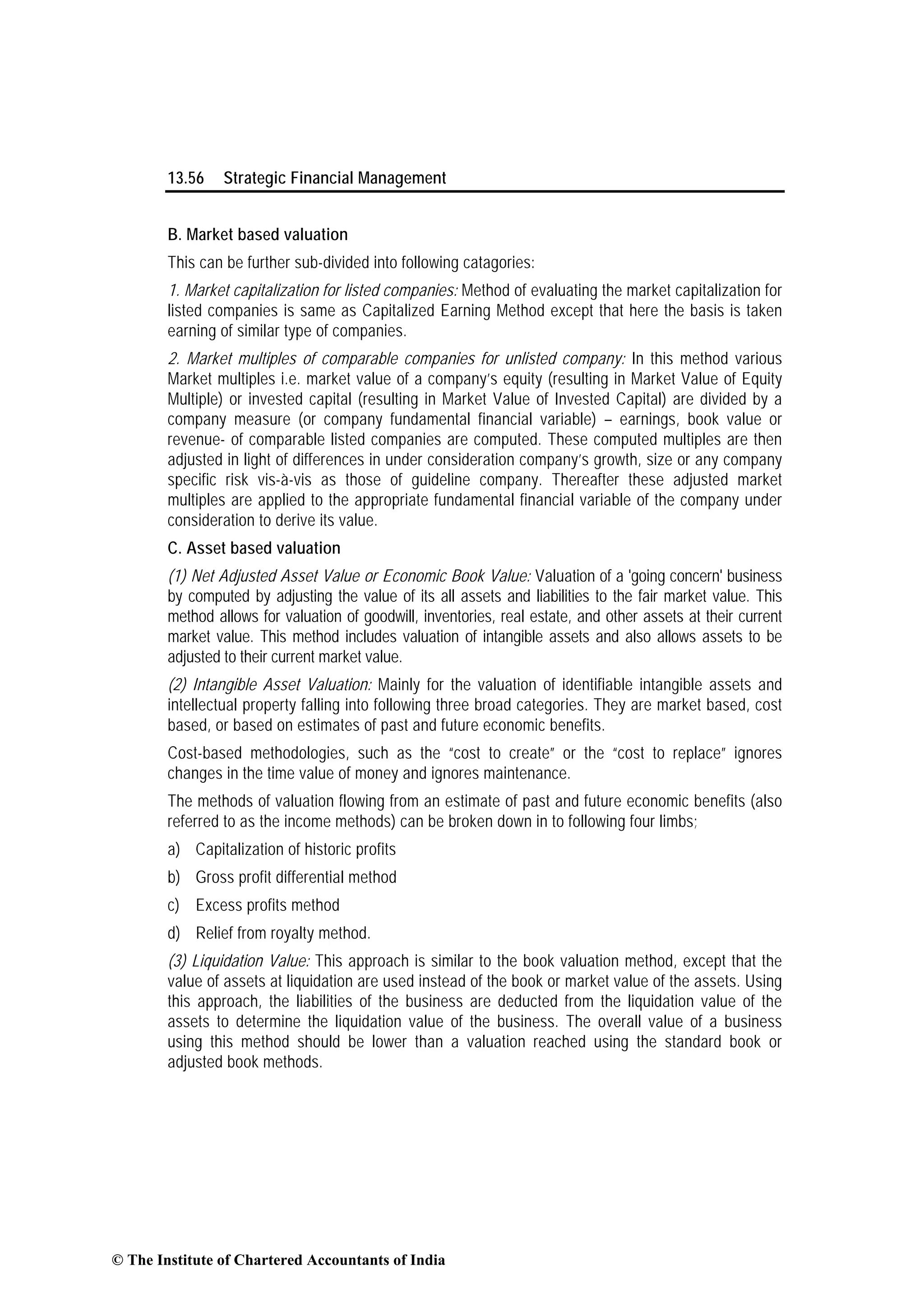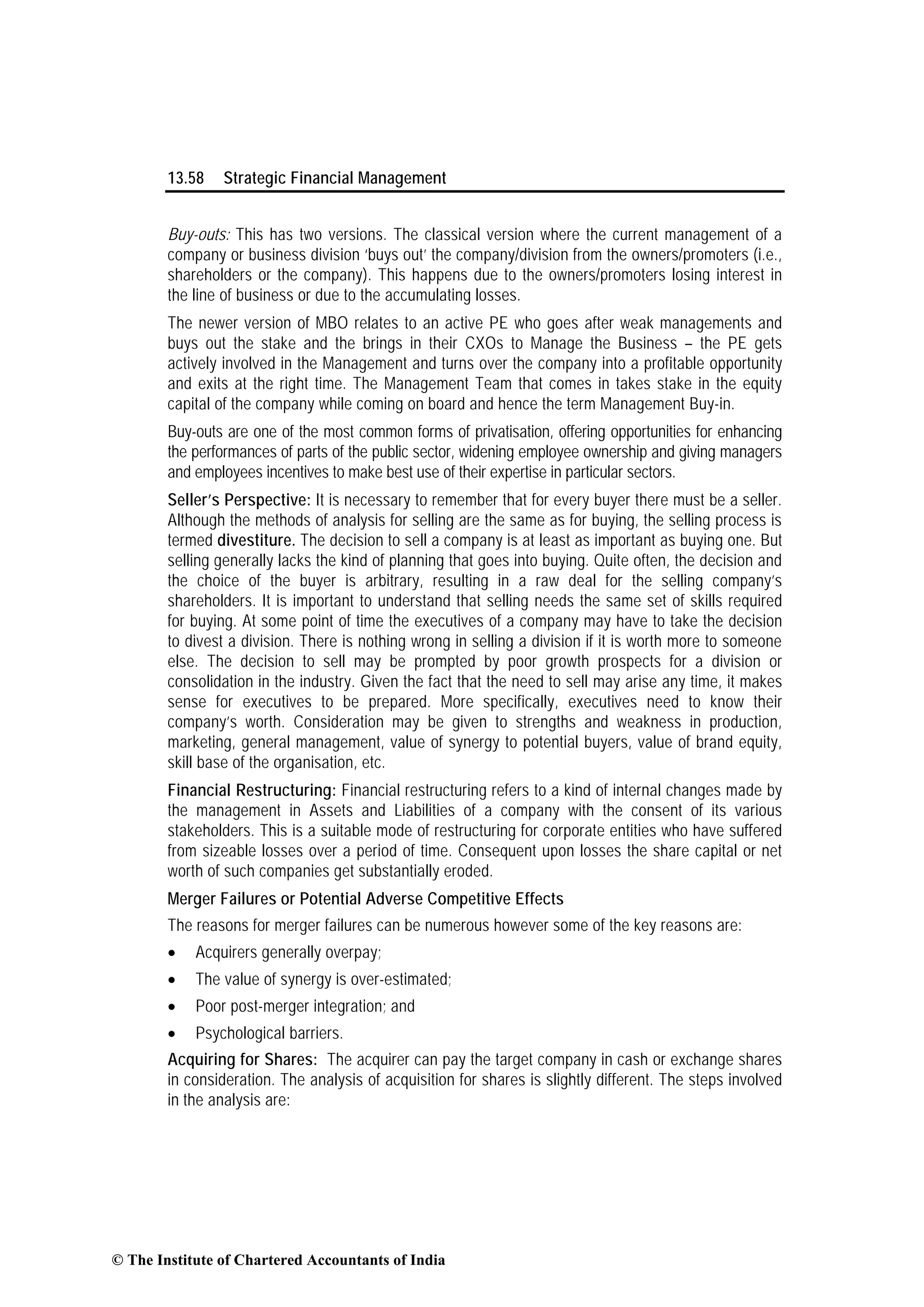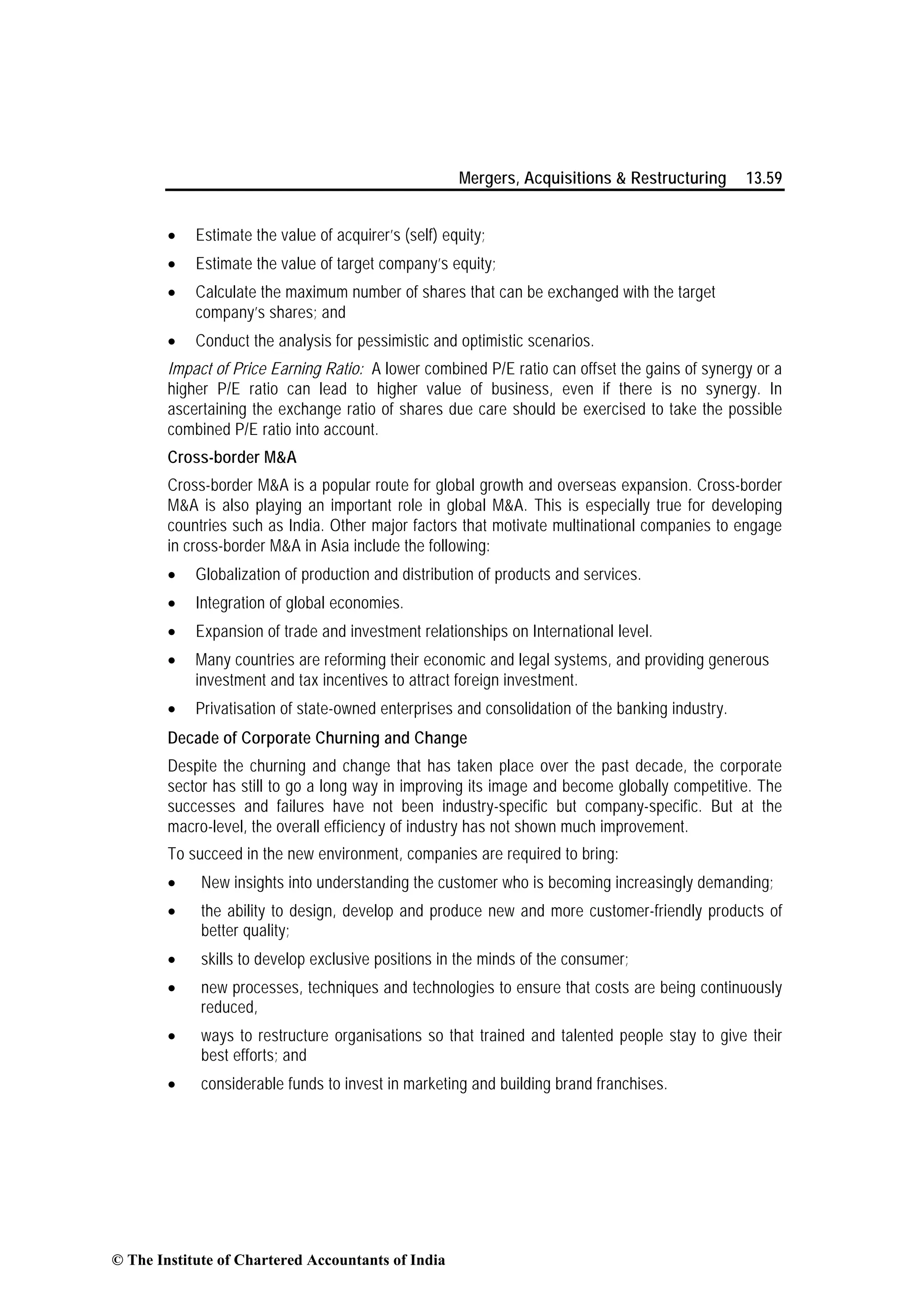This document provides an overview of mergers and acquisitions (M&A). It discusses the reasons and rationale for M&As, including synergistic operating economics, diversification, taxation benefits, and growth opportunities. The document also describes different types of mergers, such as horizontal, vertical, conglomerate, and reverse mergers. It explains the concept of synergy gains from M&As and how the combined value of the merging companies can be greater than the sum of their individual values.
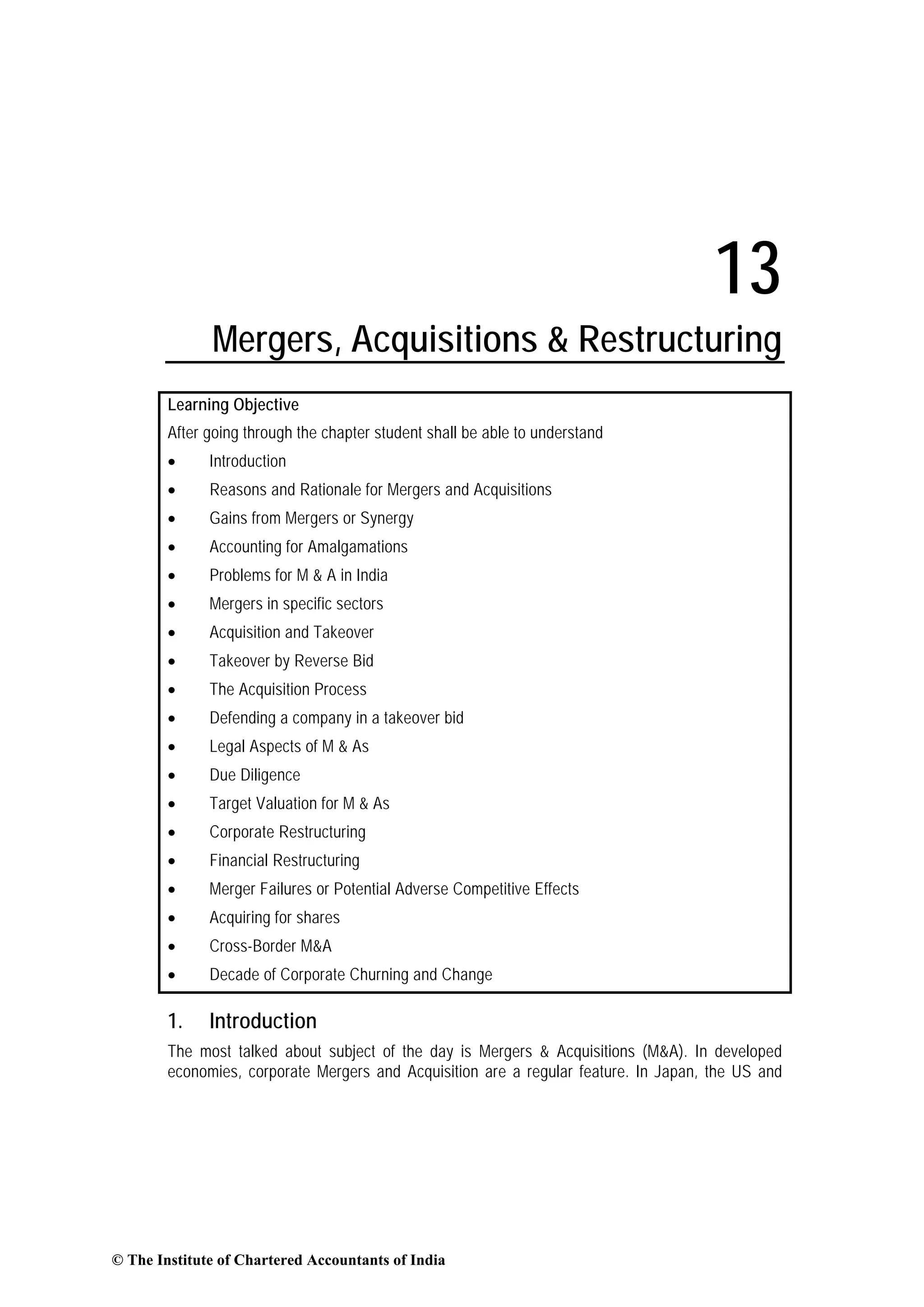

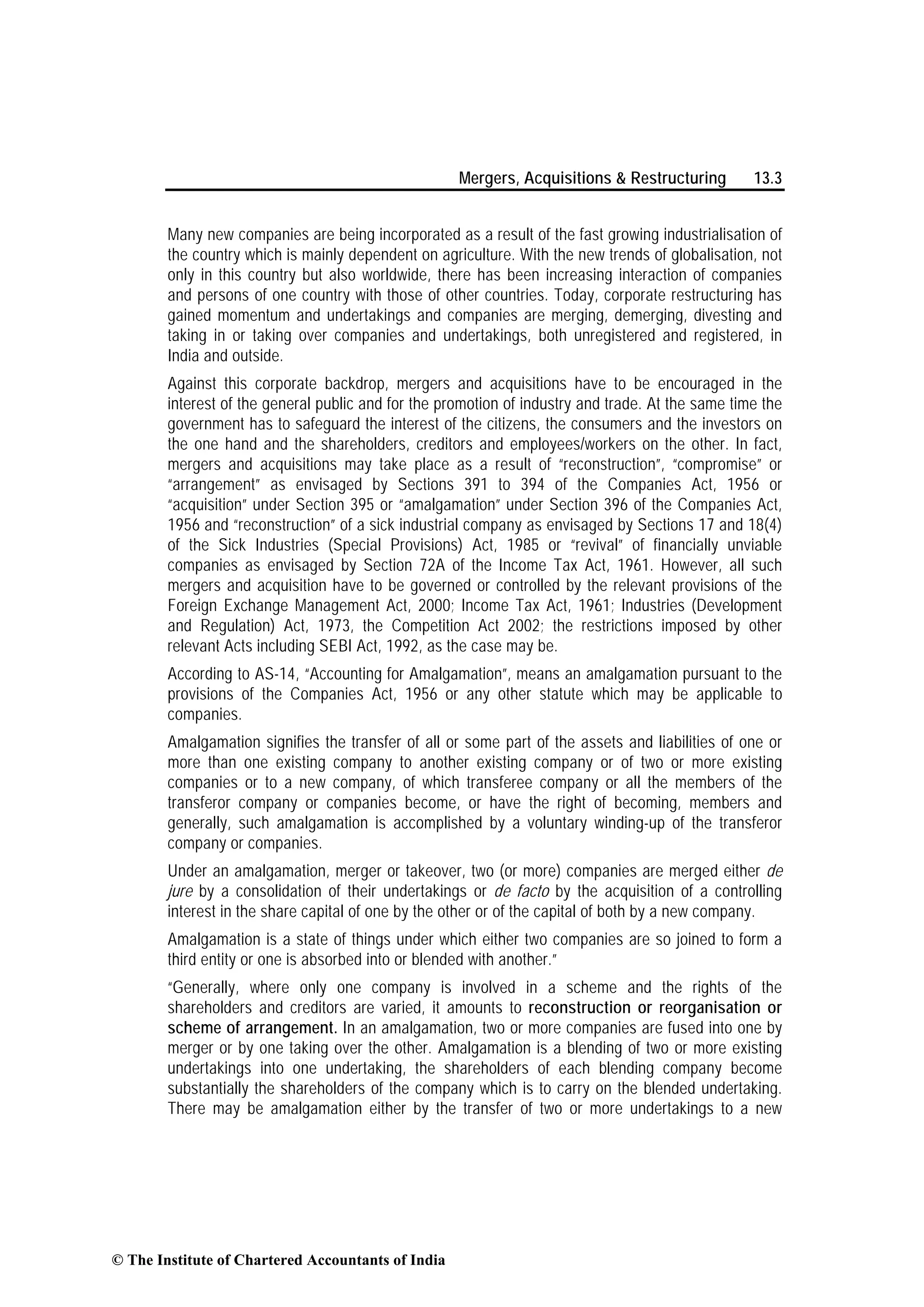
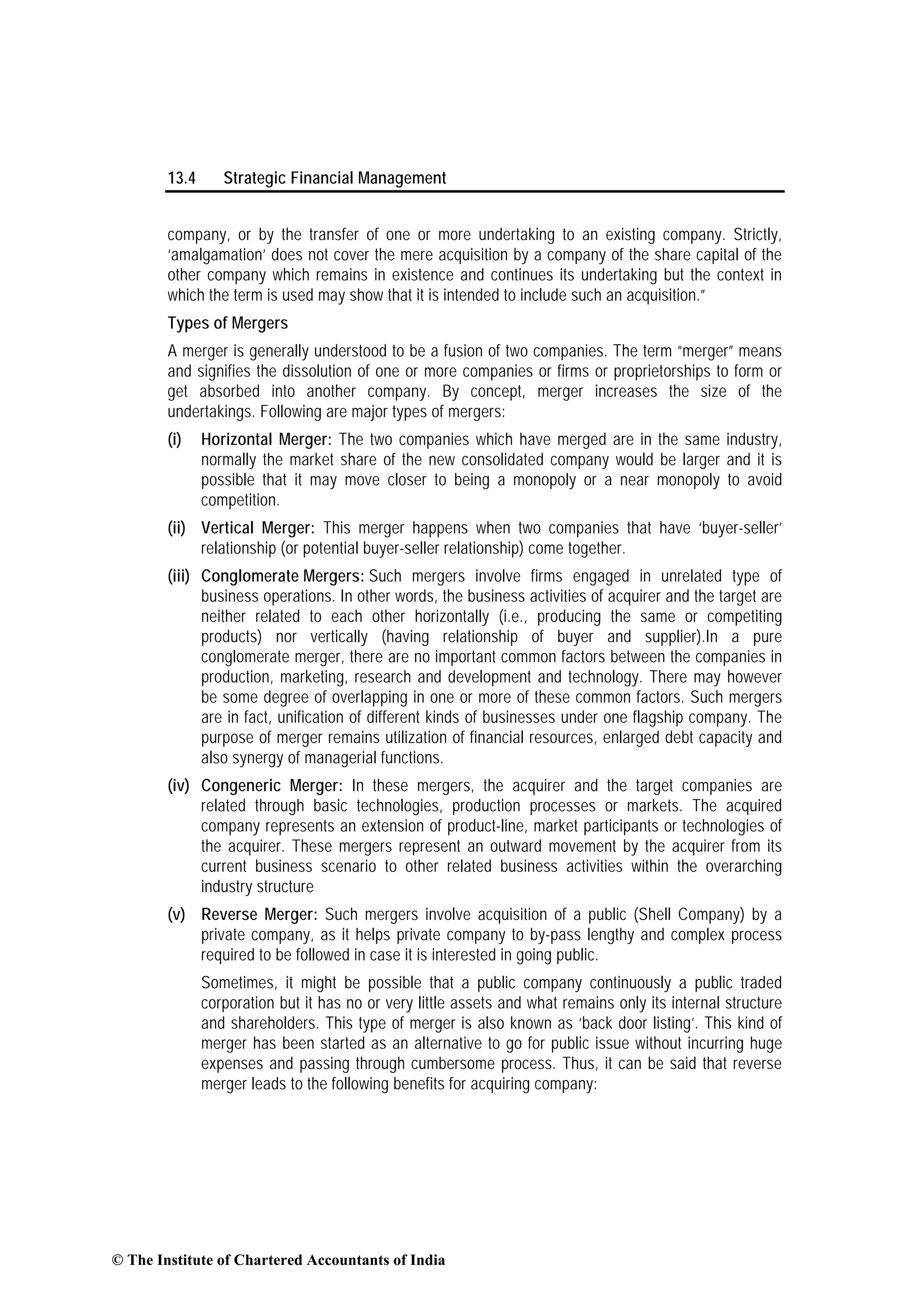
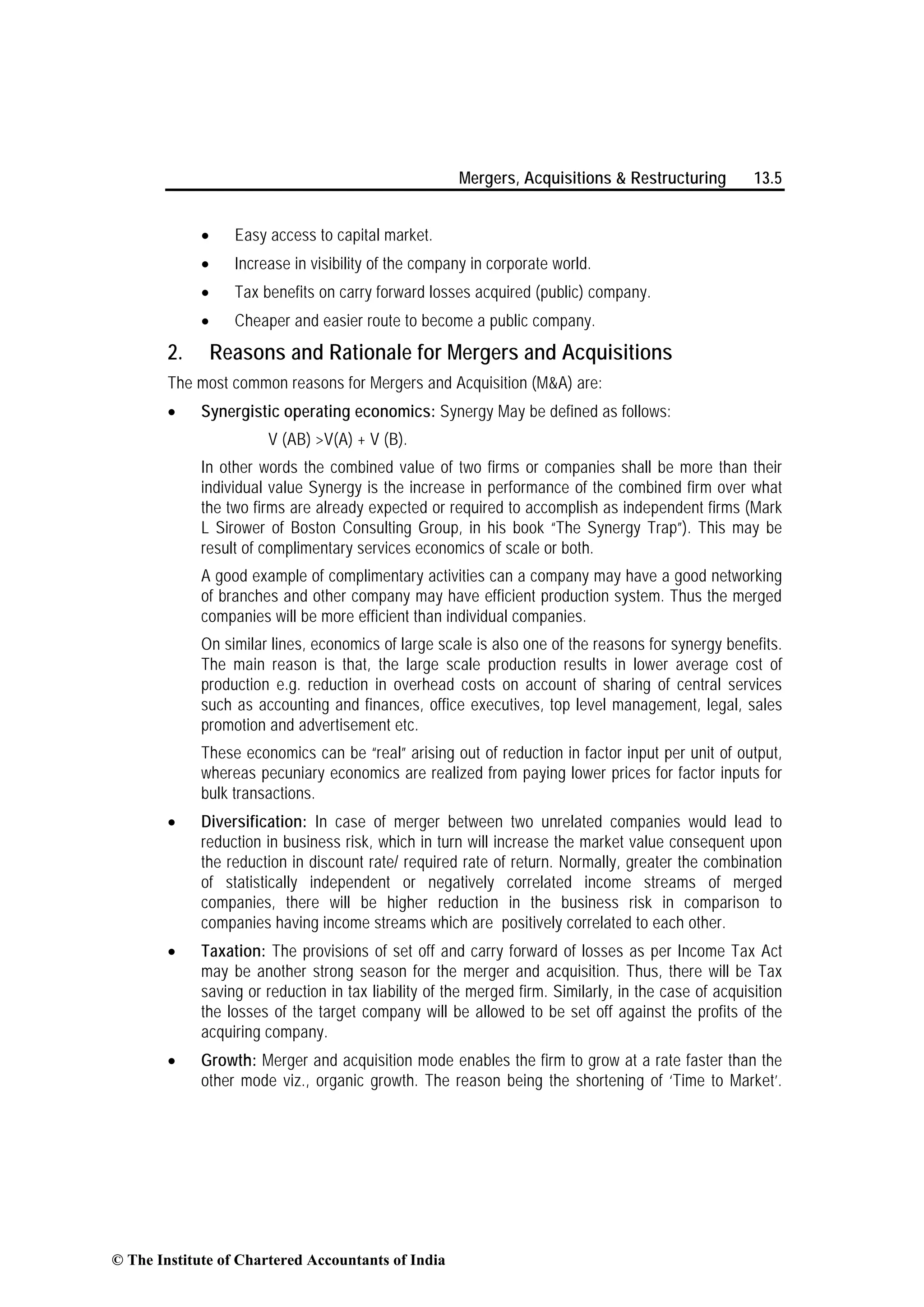


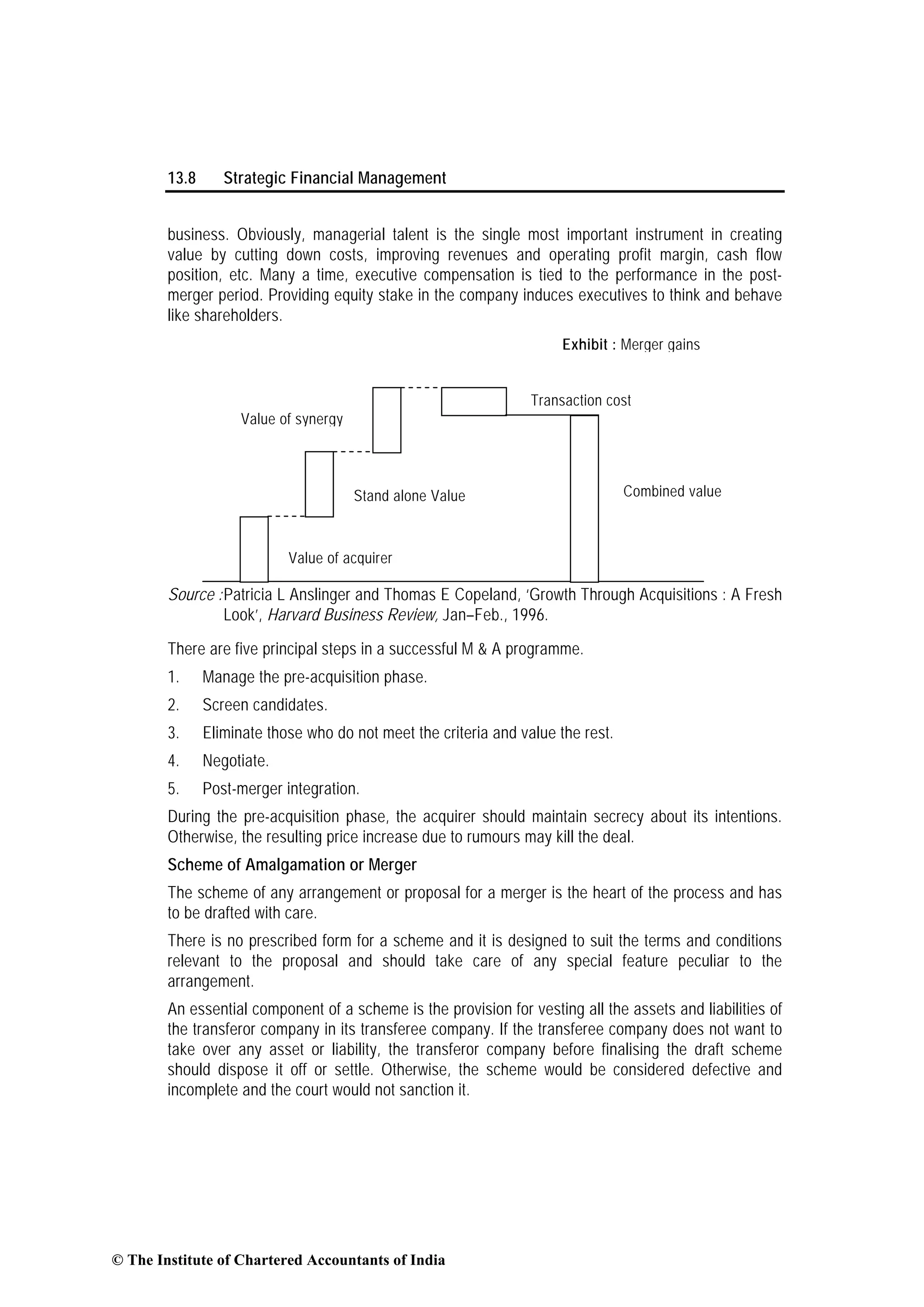
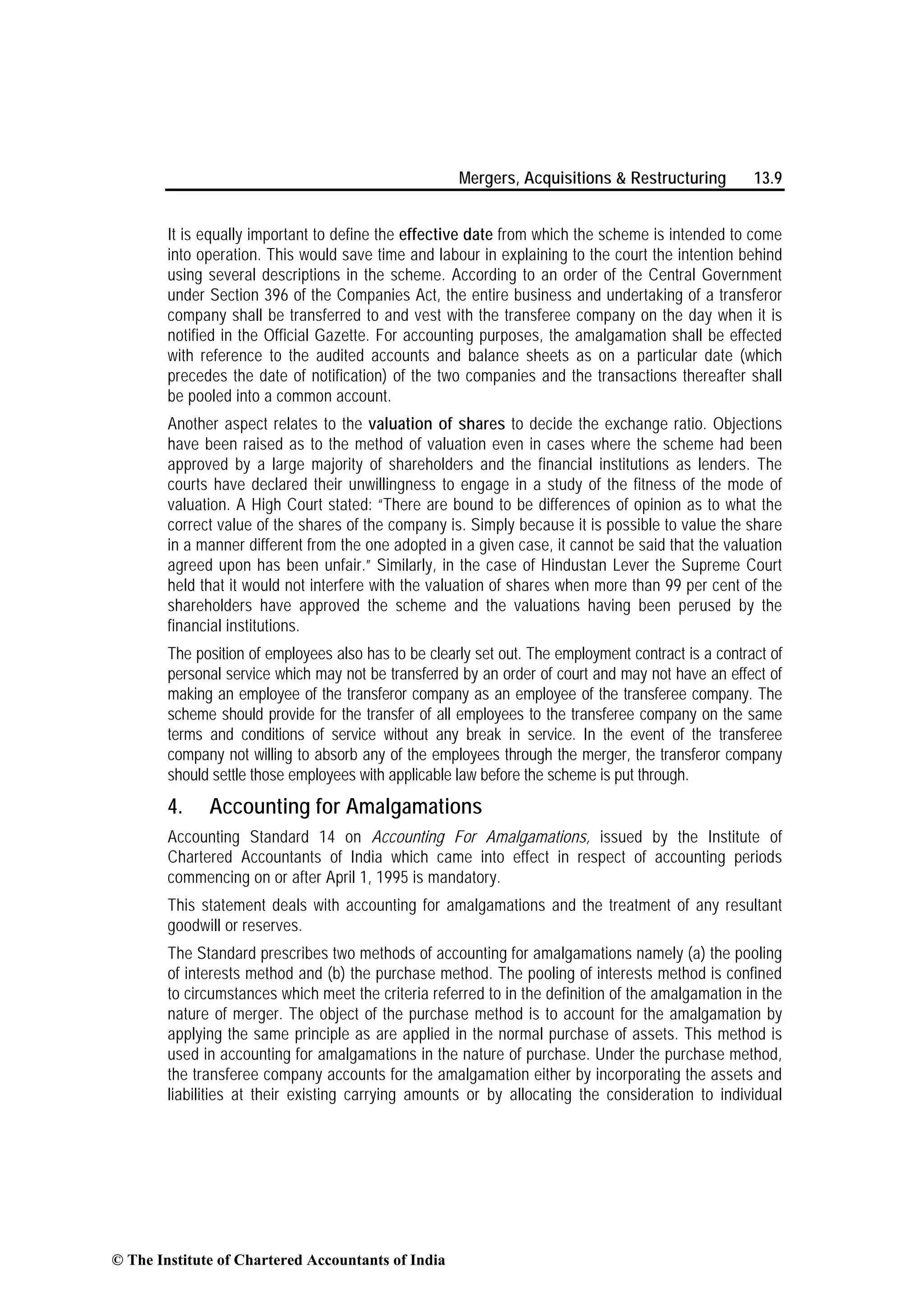
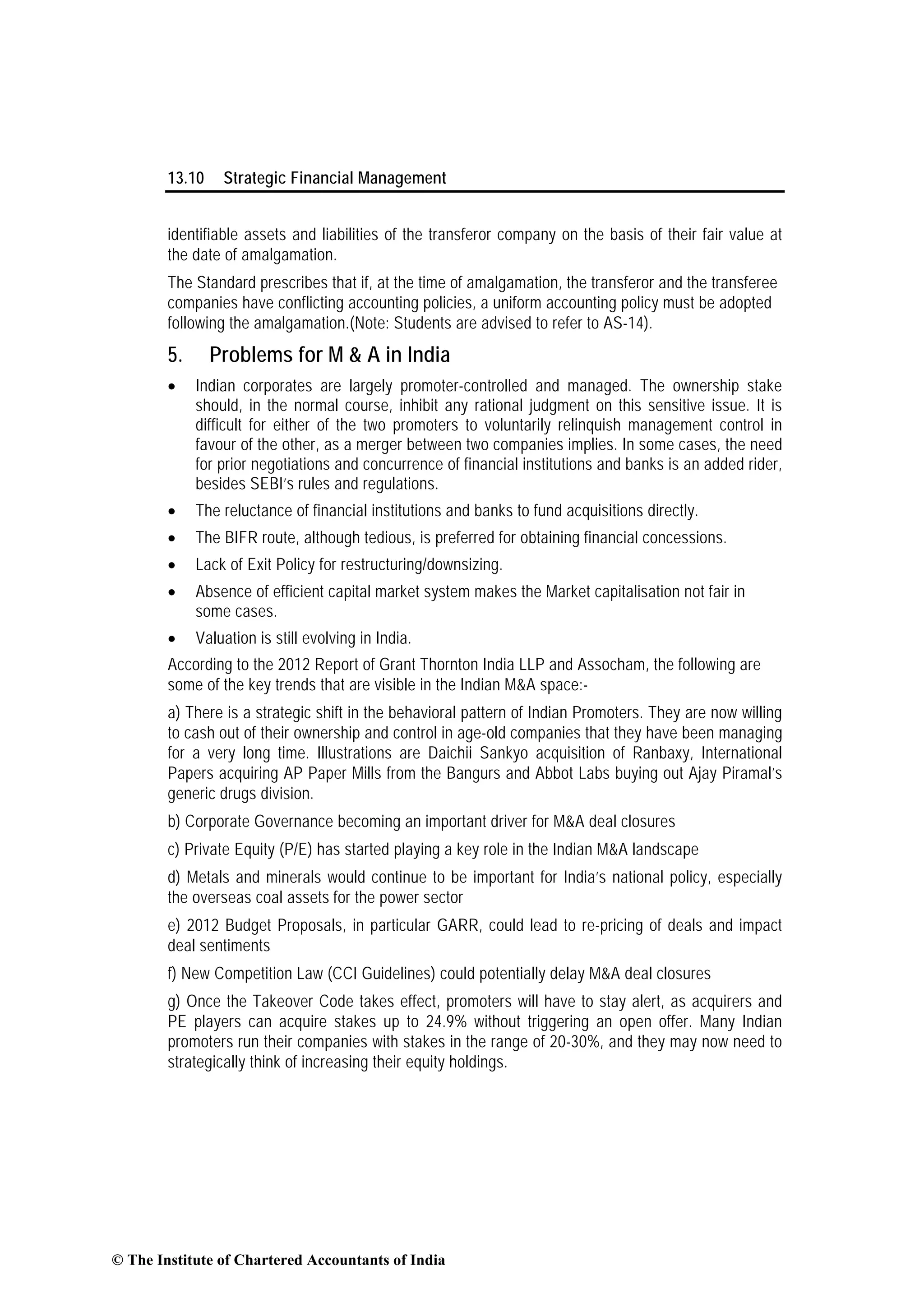
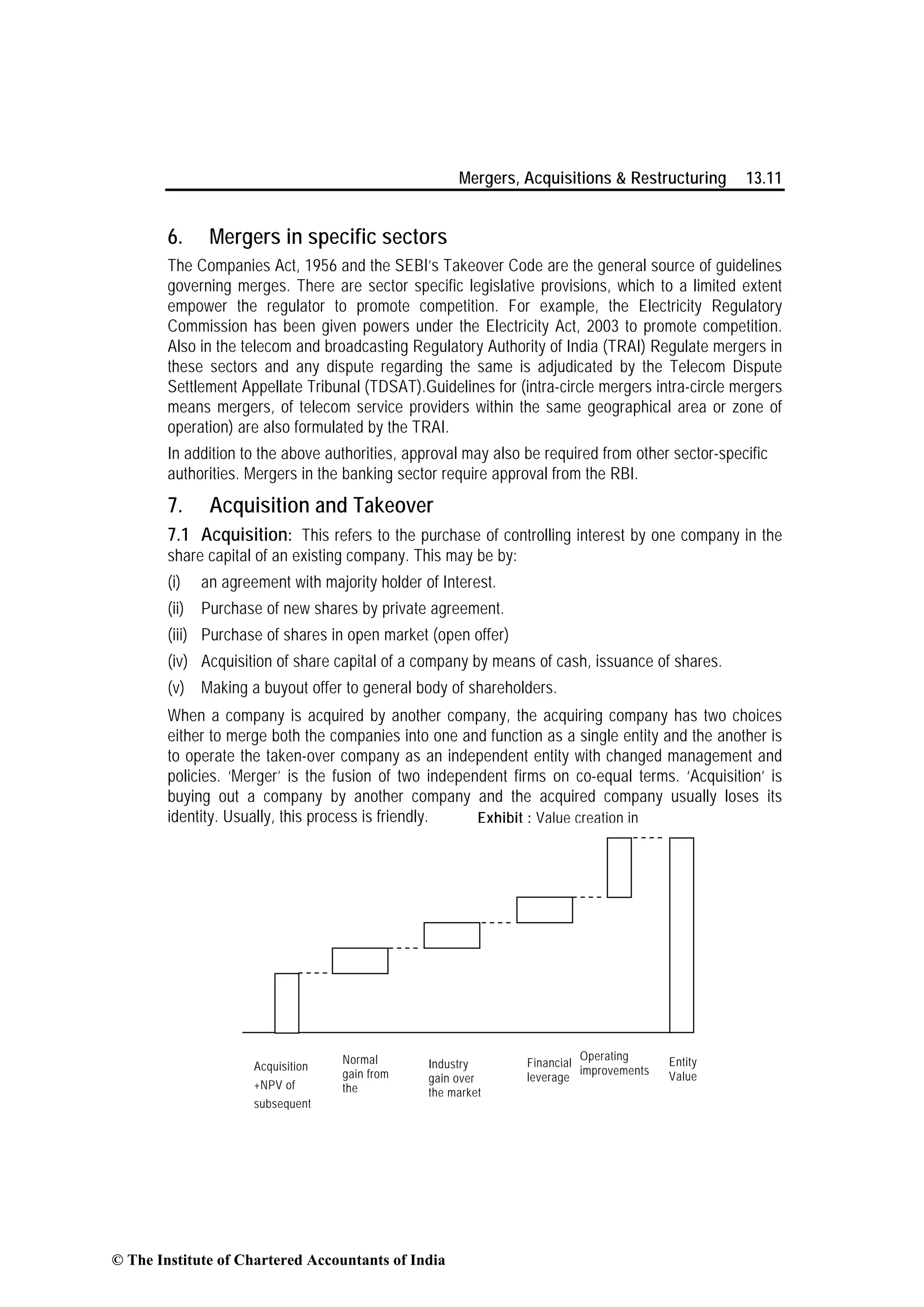
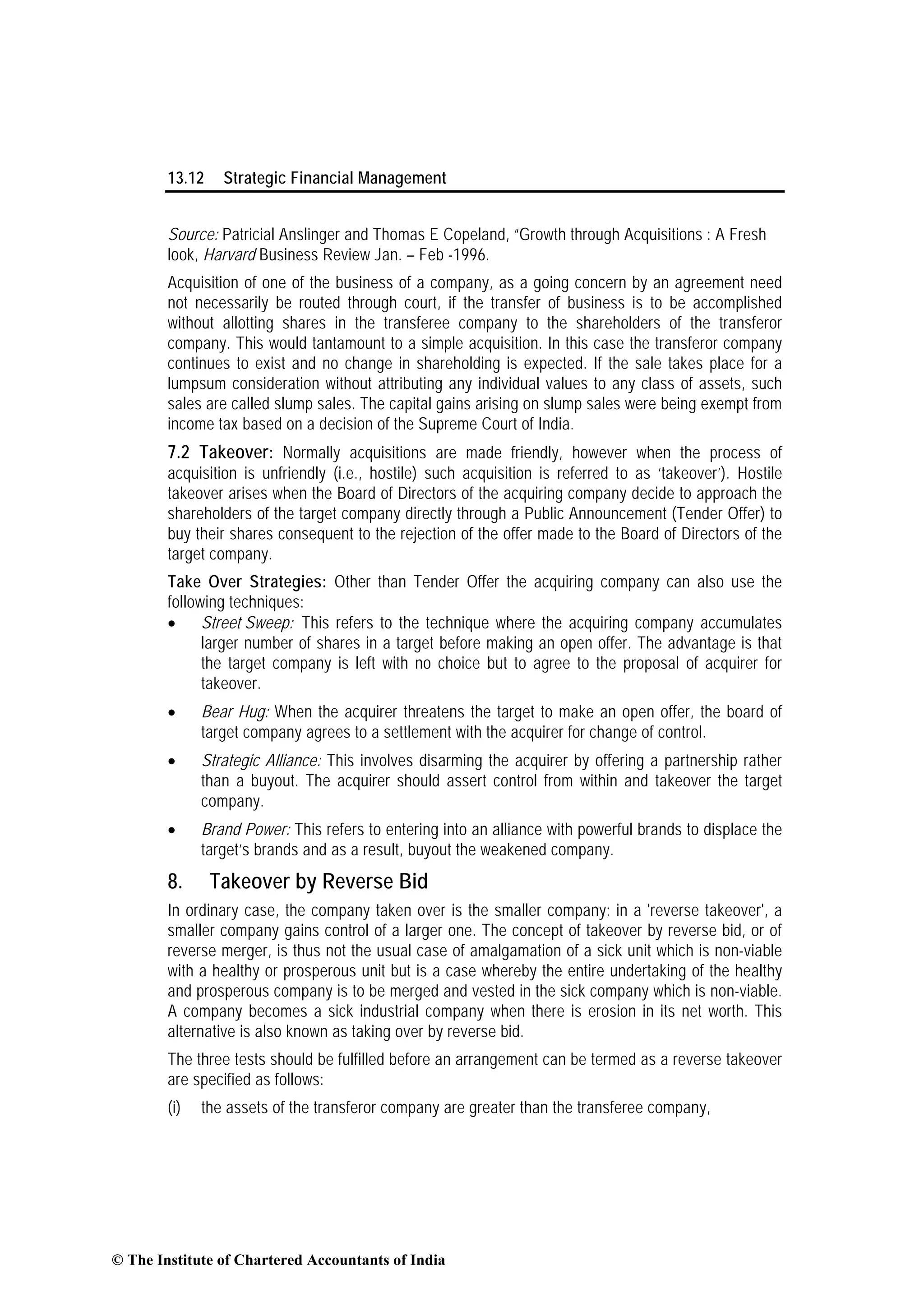
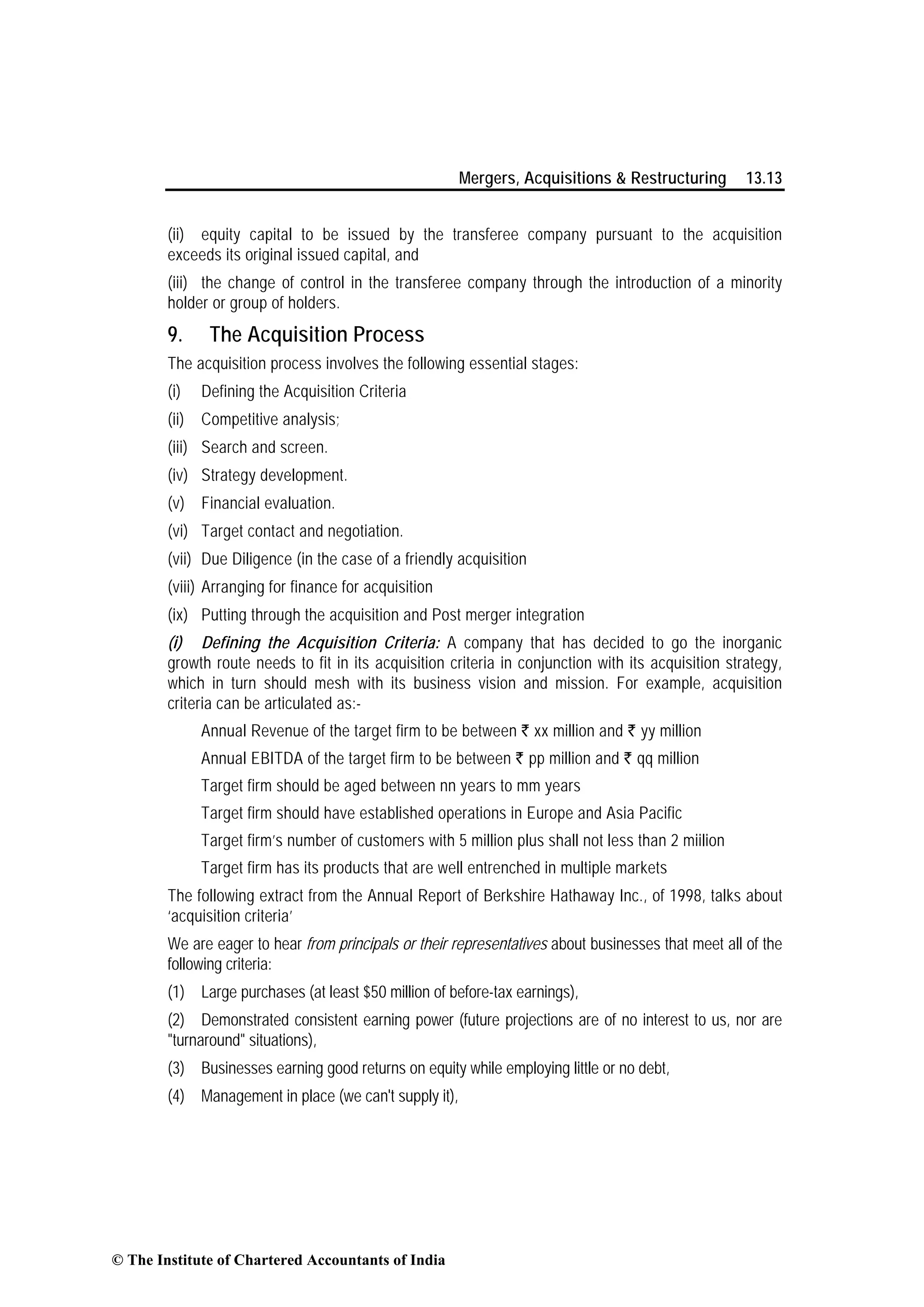
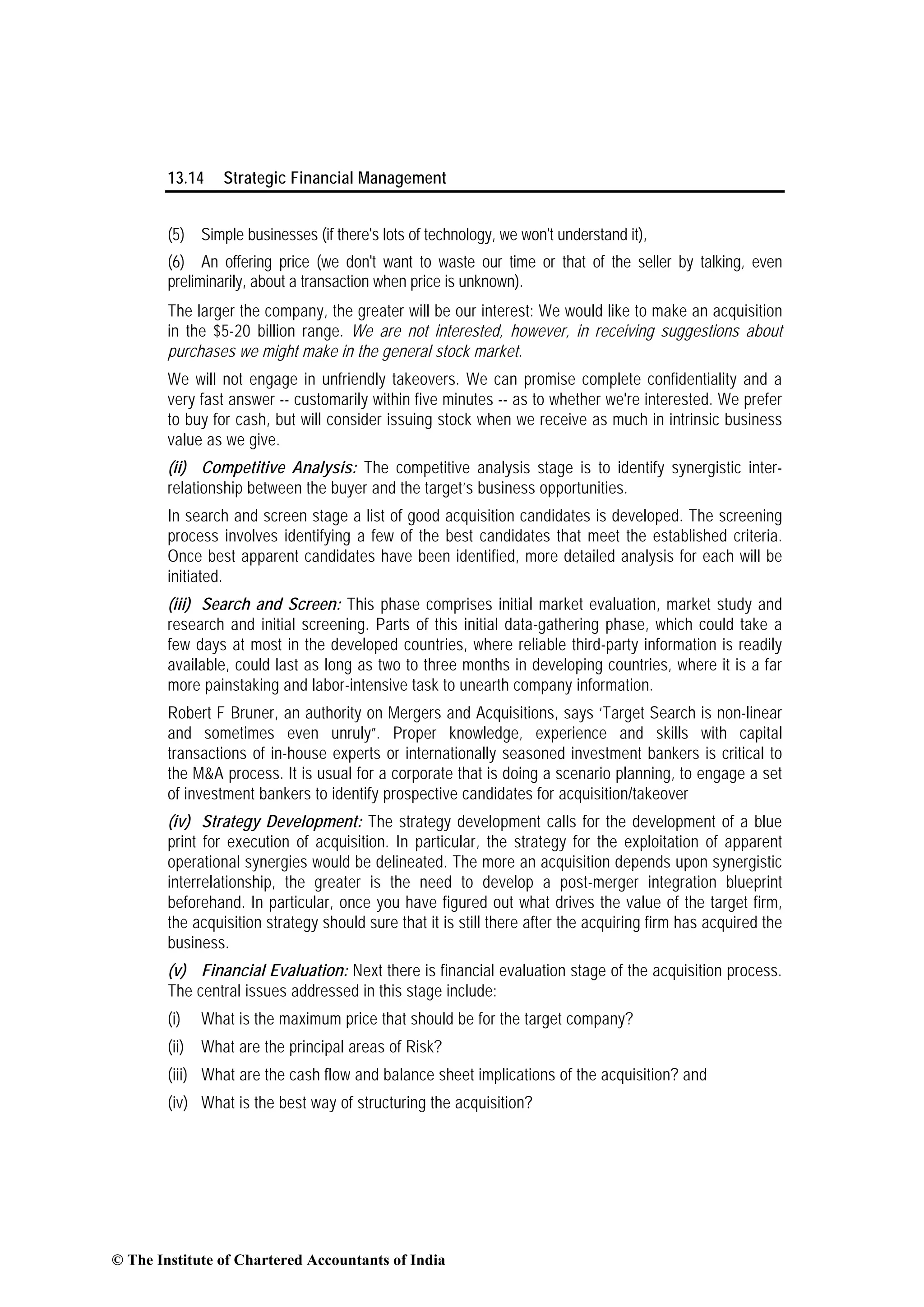
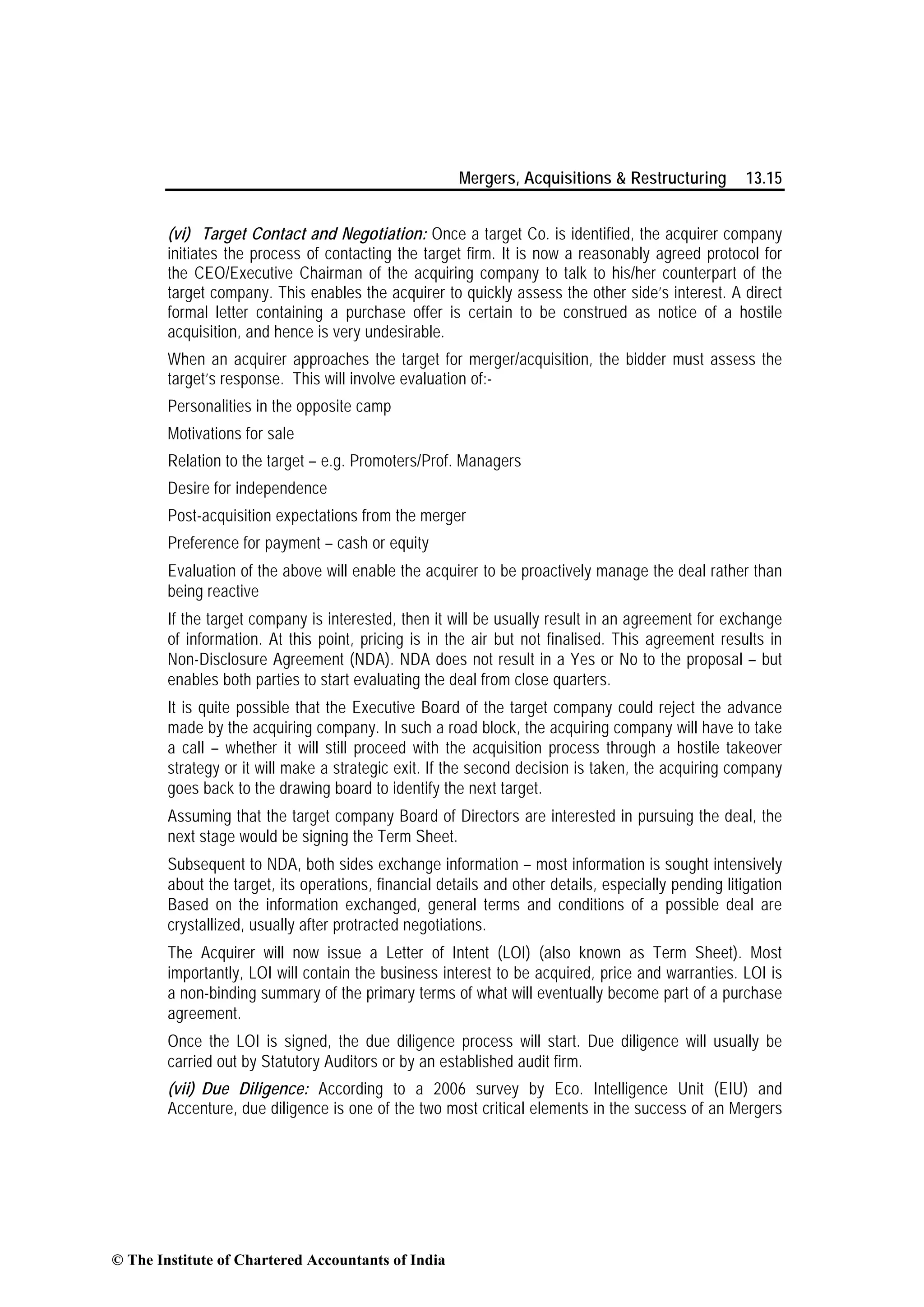
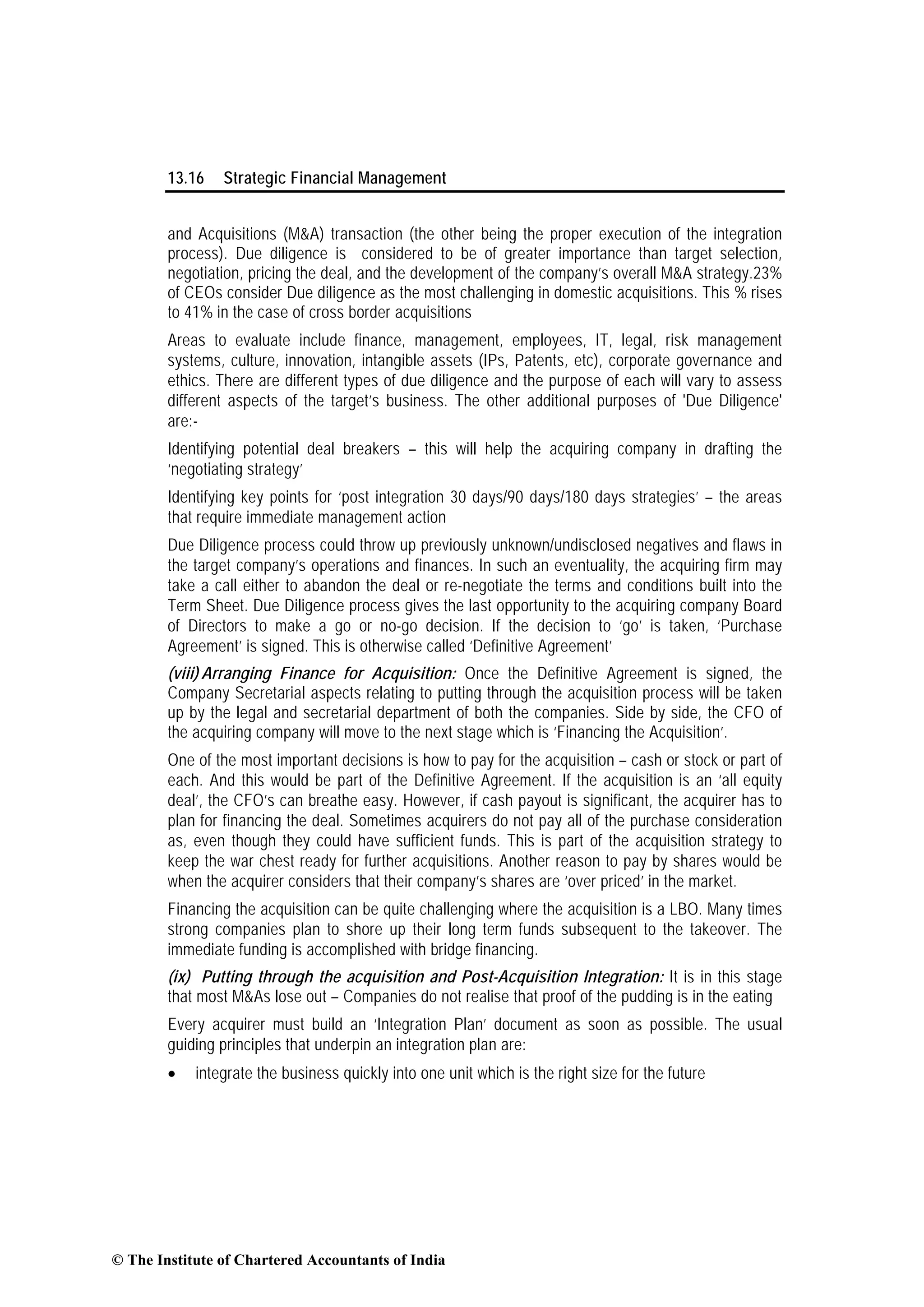
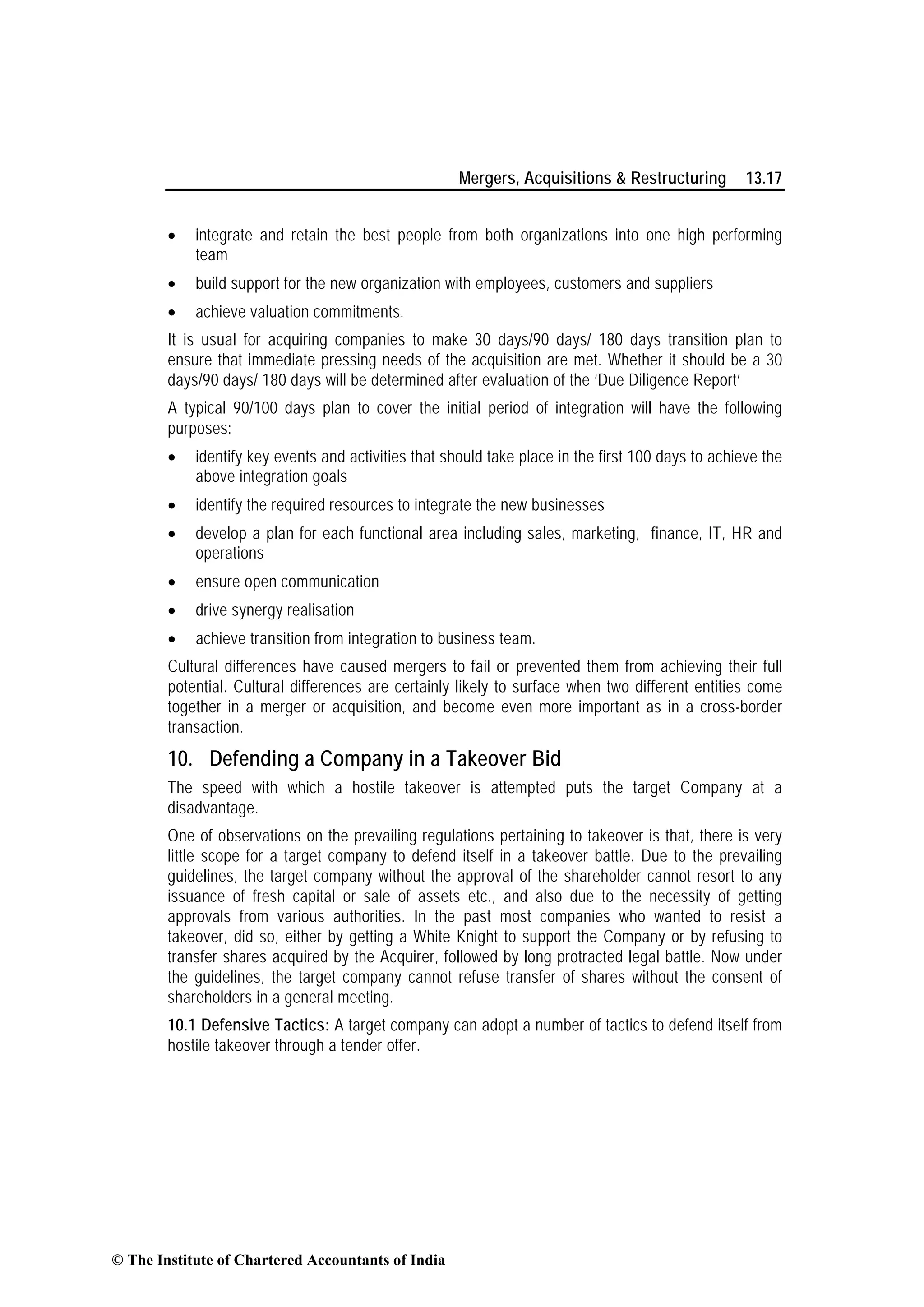

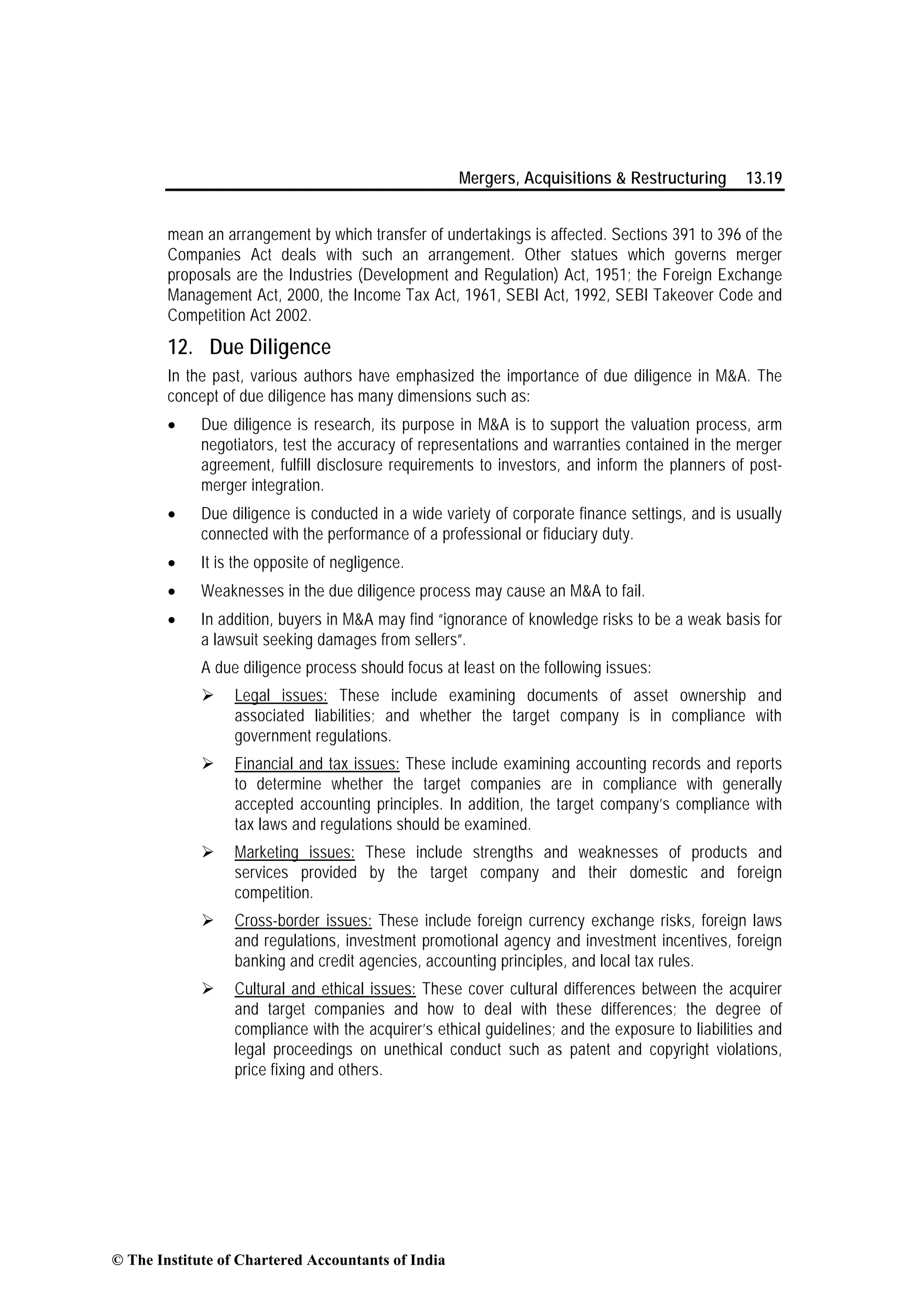
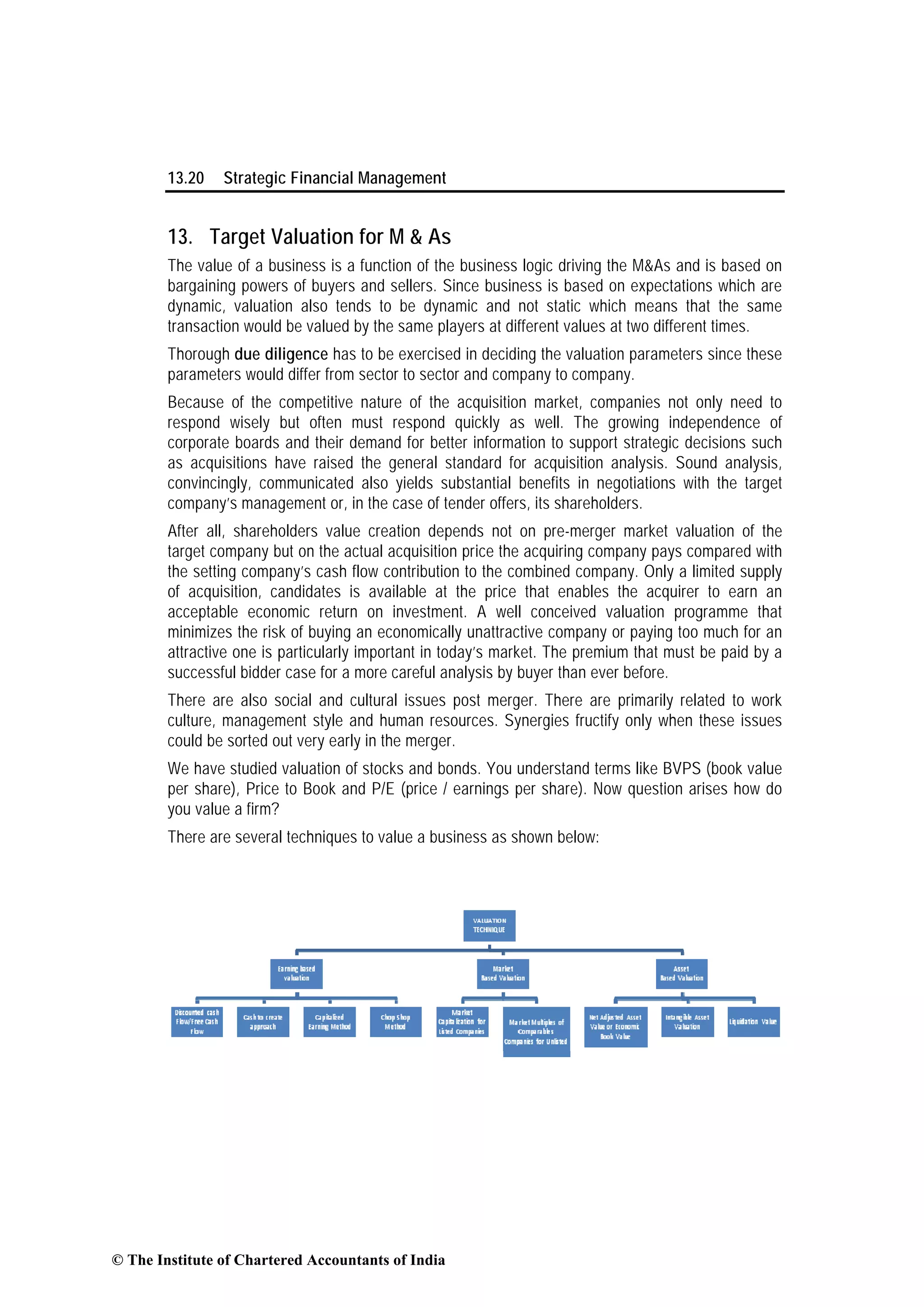
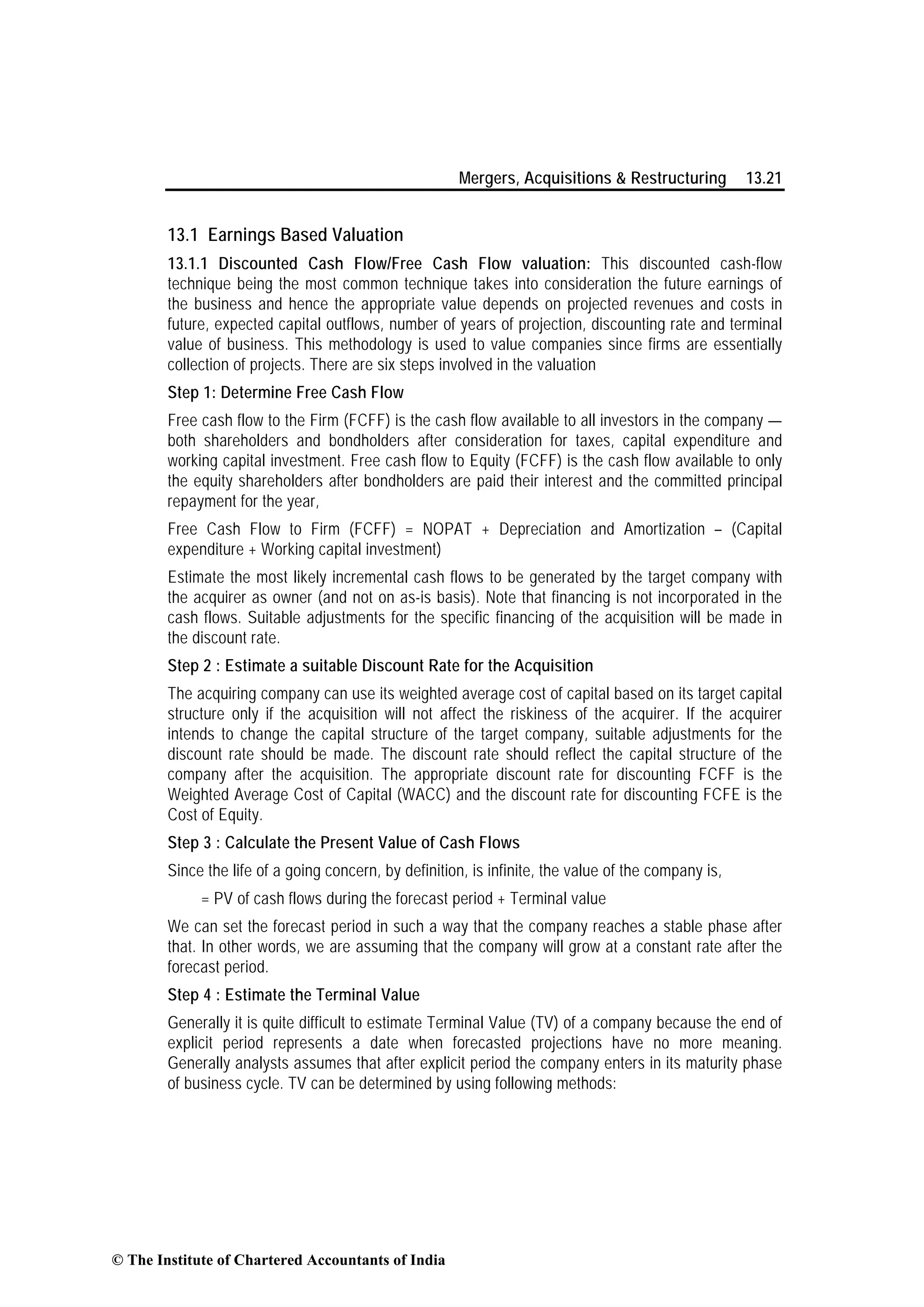
![13.22 Strategic Financial Management
(i) On the basis of Capital Employed: Usually this basis is used in some specific type of
industries e.g. mining etc. Where we estimate liquidation value by adding up realizable value
of various assets. Thus, under this method it is assumed that the company has a finite life,
therefore scrap or realizable value of all assets is computed.
(ii) On the basis of Multiple of Earnings: Under this approach TV is determined by multiplying
the forecasted terminal year profits by an available/appropriate price earning multiple.
Normally, the current P/E multiple can also be used as proxy for future P/E multiple and can
be calculated as follows:
TV = Current market value of company/Current profit after tax
Suppose, if the current market value of company is ` 576.20 crore and profit after tax is `
82.30 crore,
Then P/E = 576.20/82.30 = 7
Further if last year’s profit are ` 201.20 crore, then TV shall be
= Last year’s profit × P/E multiple
= ` 201.20 crore × 7 = Rs` 1408.40 crore
(iii) On the basis of Free Cash Flow: This is one of the popular method of estimating TV
because future expected cash flows are discounted at a rate that reflects the riskiness of the
projected cash flows.
It should however be noted that following two approaches can be employed to compute the
TV.
(a) Growing Perpetuity: Under this approach we assume that cash flow grows at a constant
rate after forecasted period and it is calculated as follows:
TV = [CFt (1 + g)] / (k – g)
where,
CFt = Cash flow in the last year
g = Constant Growth Rate
k = Discount rate or Cost of Capital
(b) Stable Perpetuity: This approach is followed when there is no Capital Expenditure or if it
is there then it is equal to depreciation charged. In other words capital does not grow any
more. In such situations cash flows becomes equal to Profit After Tax (PAT). Therefore,
we can assume that the company earns a rate of return on capital employed is equal to
Cost of Capital irrespective of Sales Growth.
The TV in such case shall be calculated as follows:
TV = Free Cash Flow/ Discount Rate (Cost of Capital)
= FCF/k
© The Institute of Chartered Accountants of India](https://image.slidesharecdn.com/chapter-13-merger-acquisitions-restructuring1-150606190922-lva1-app6892/75/Chapter-13-merger-acquisitions-restructuring-1-22-2048.jpg)
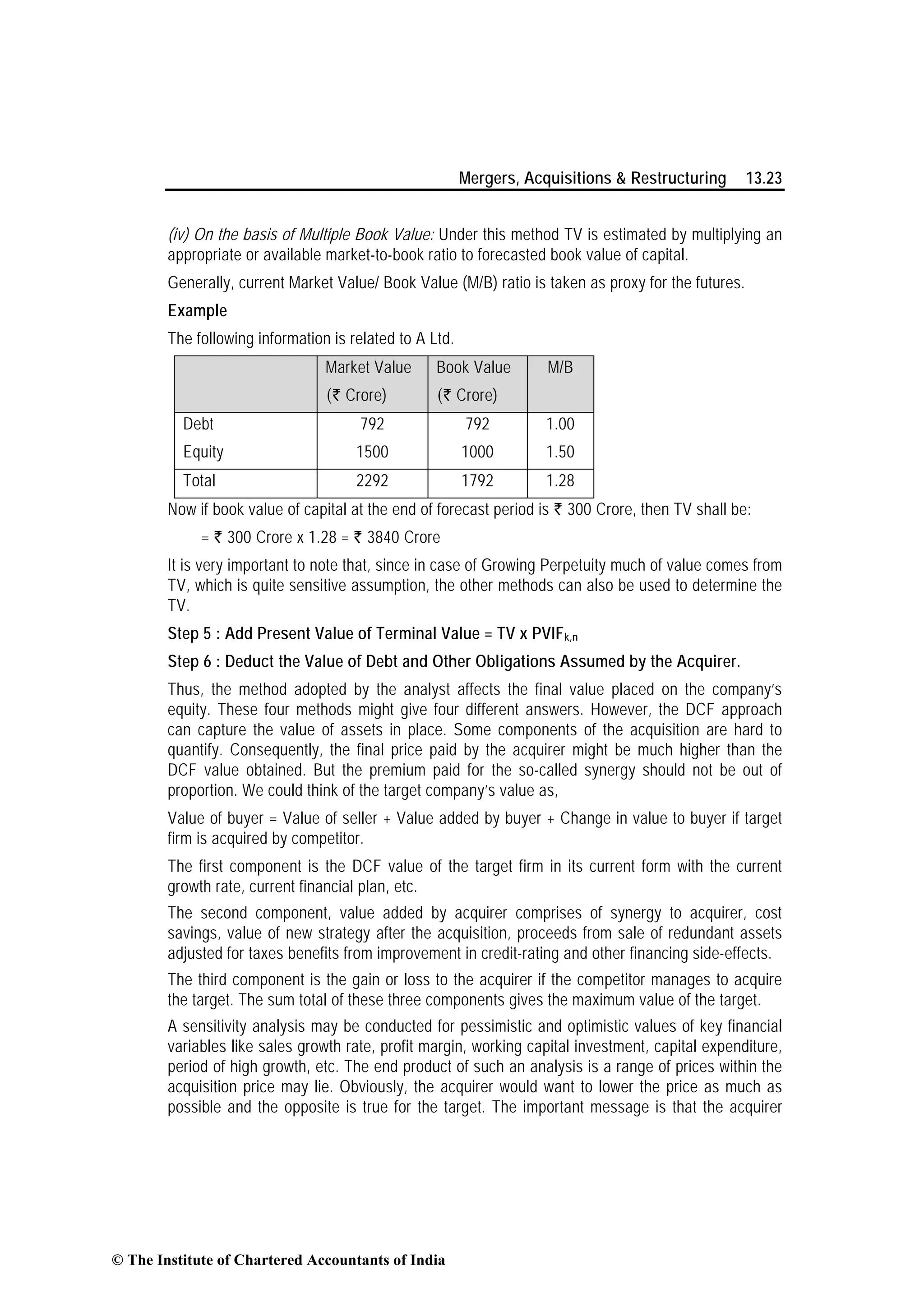
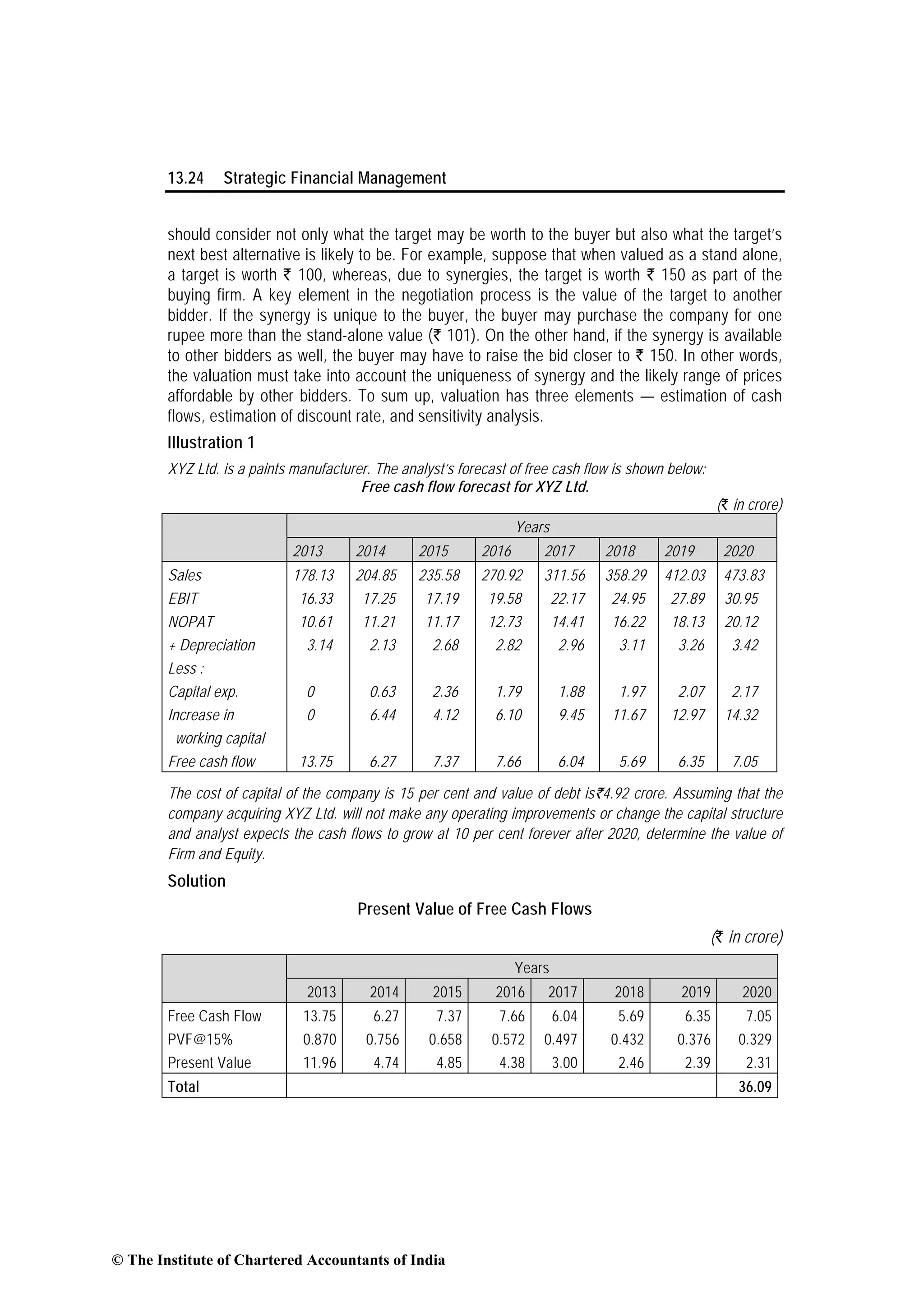


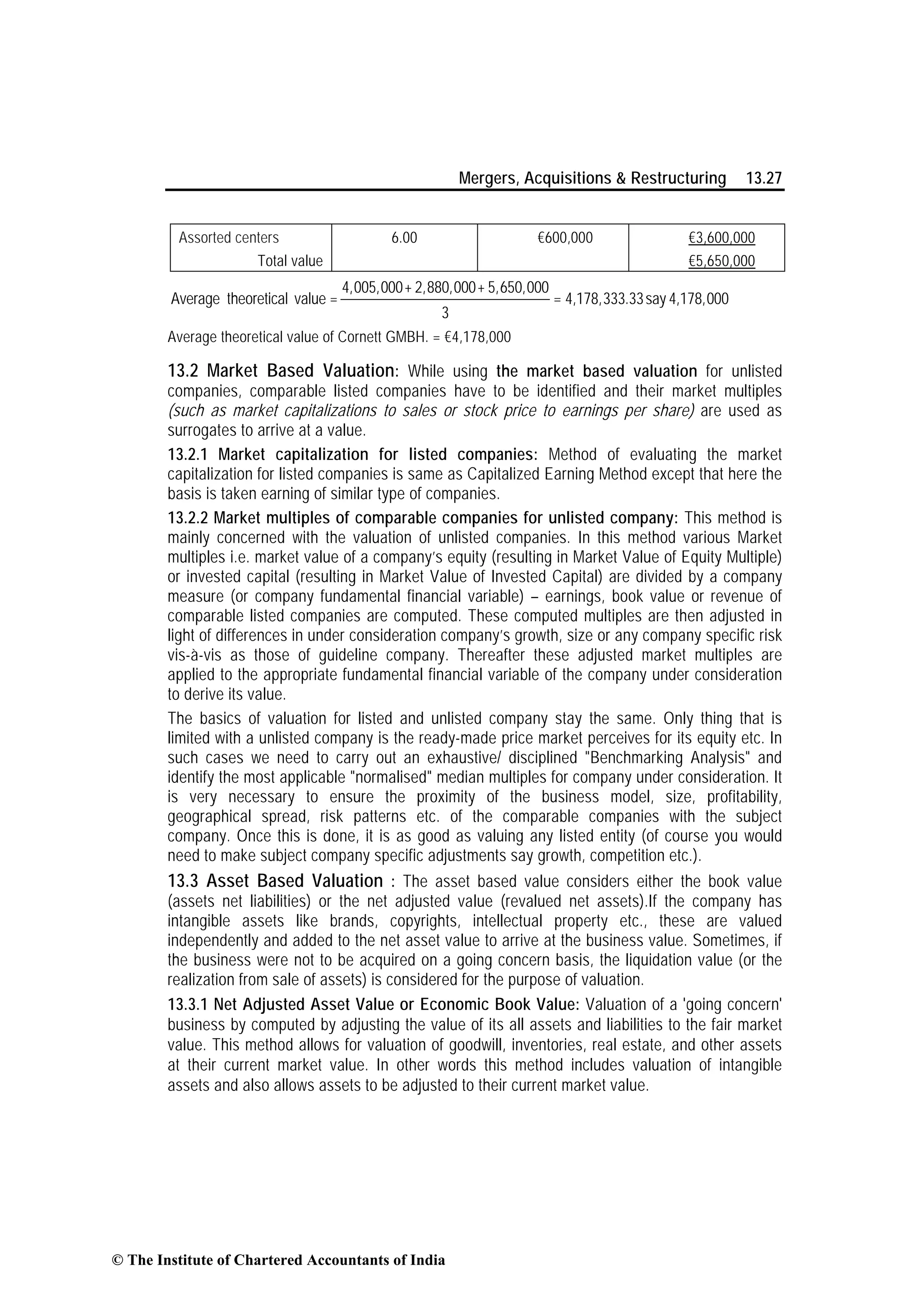
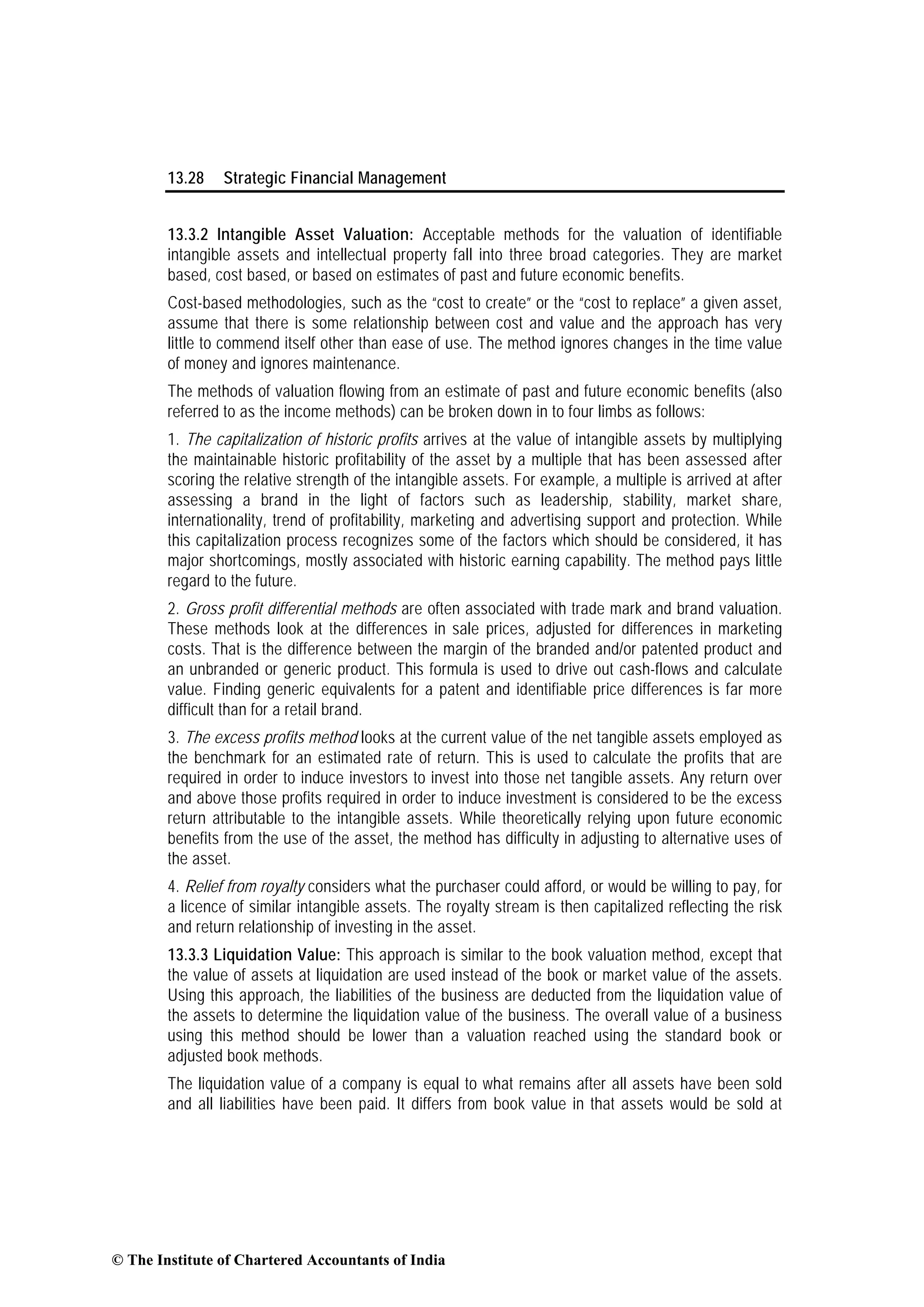

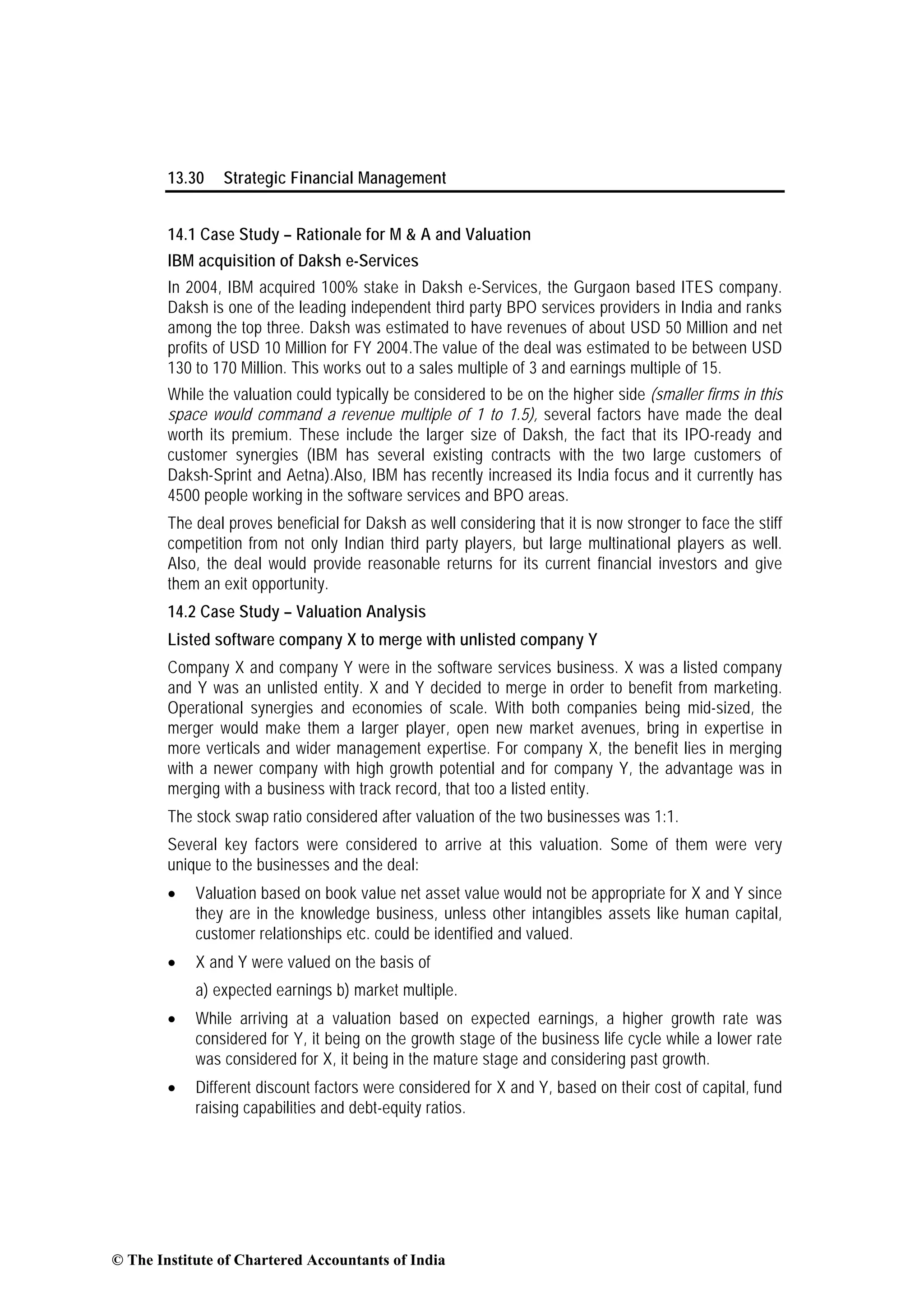




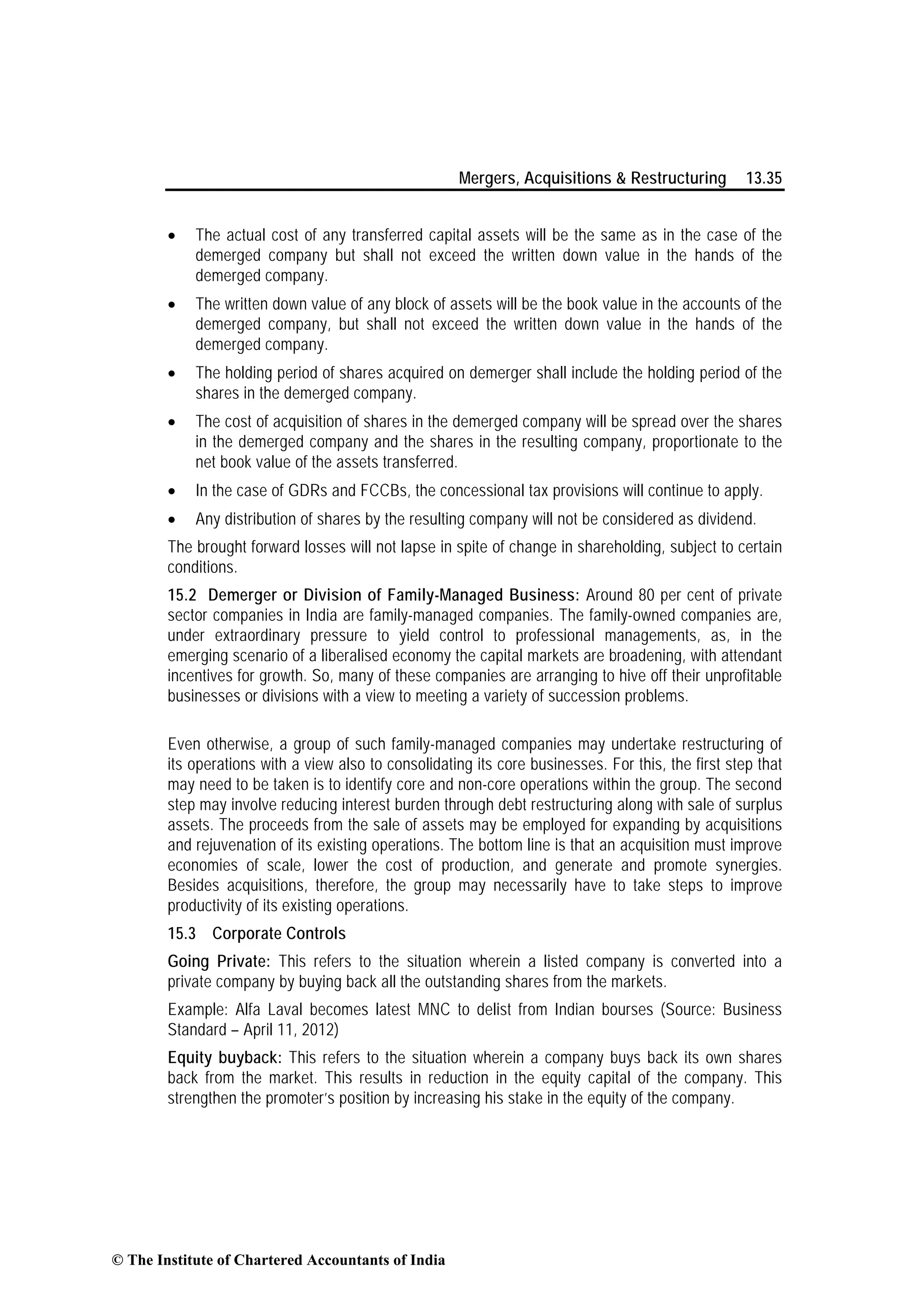
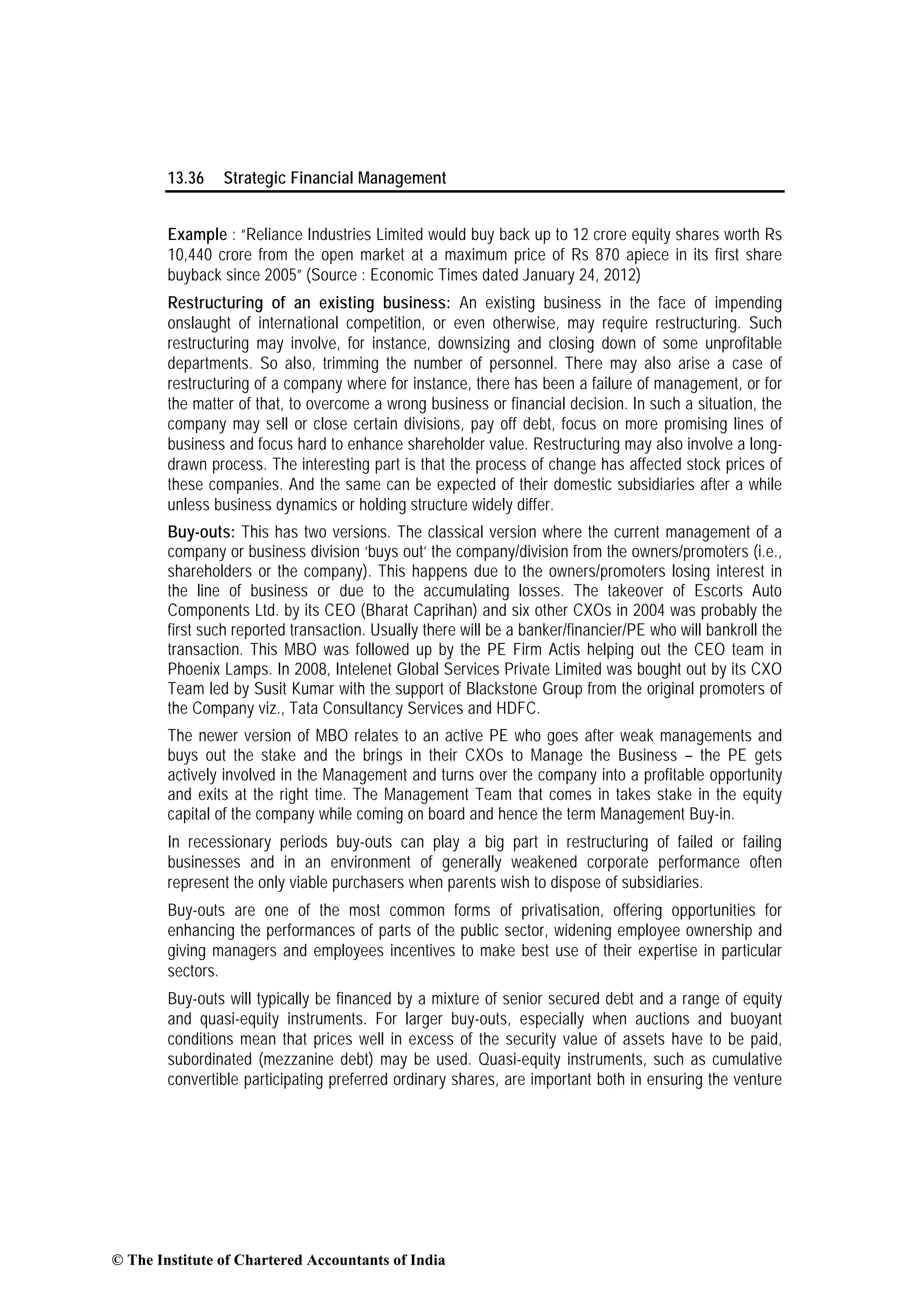


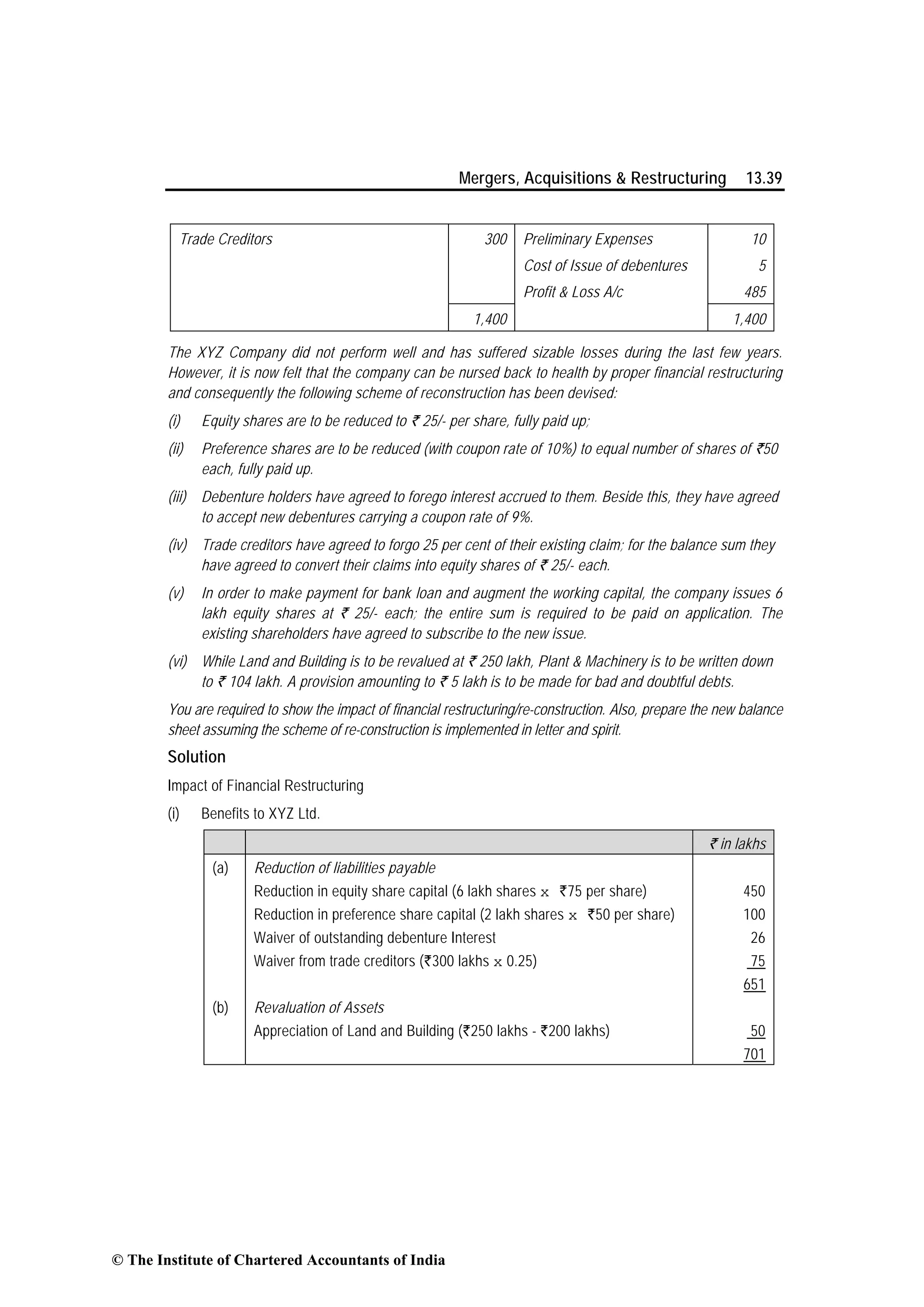
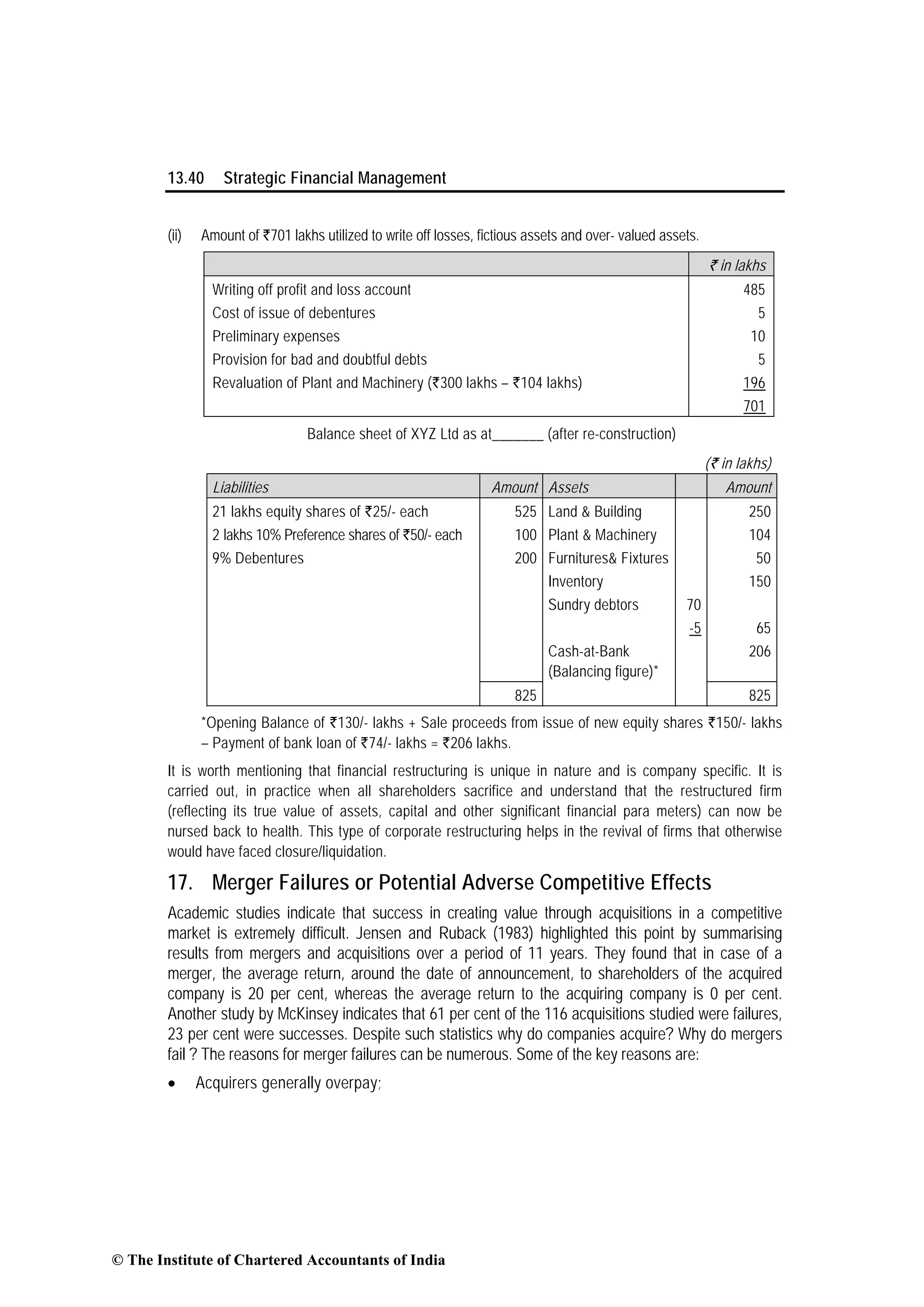
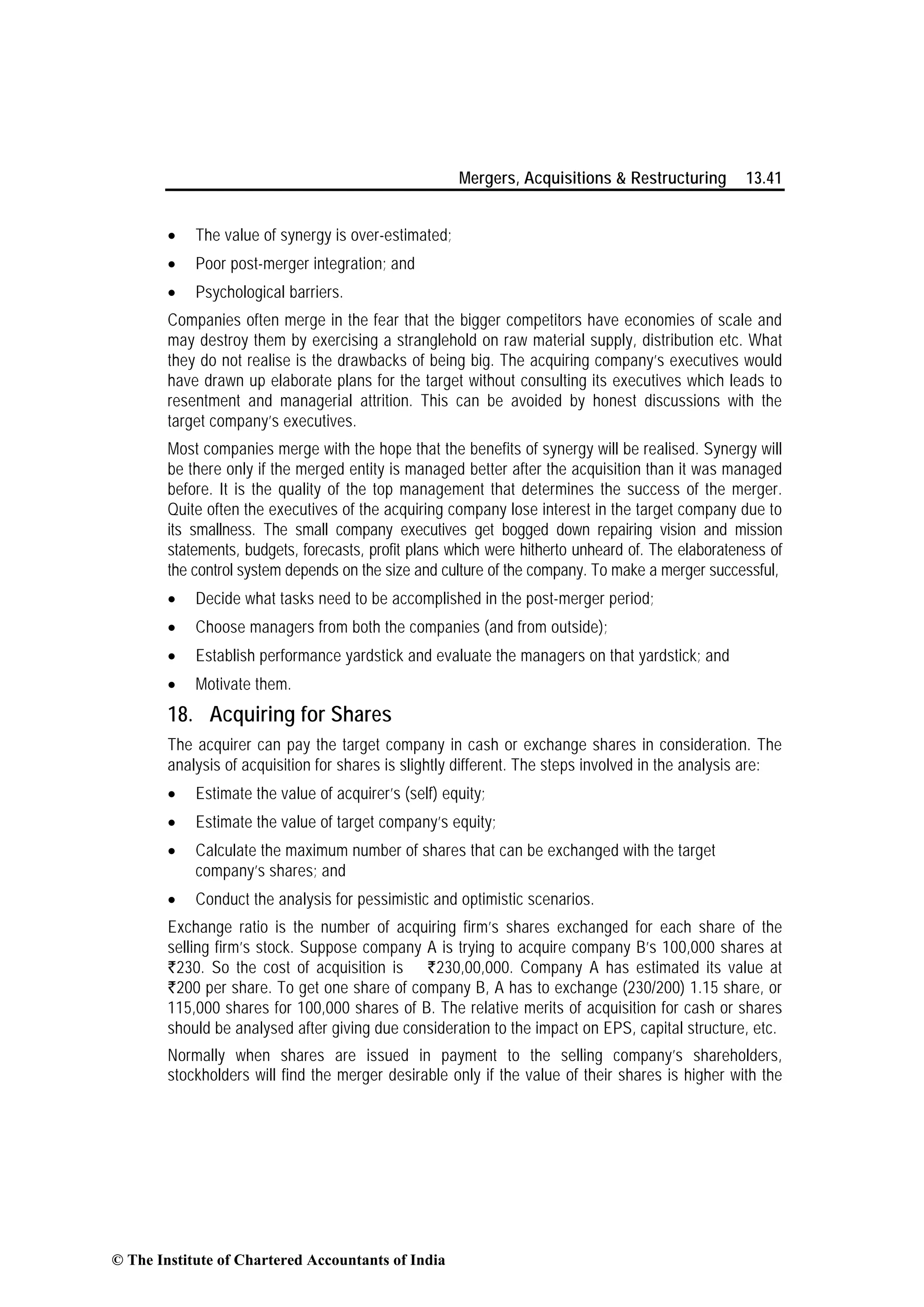
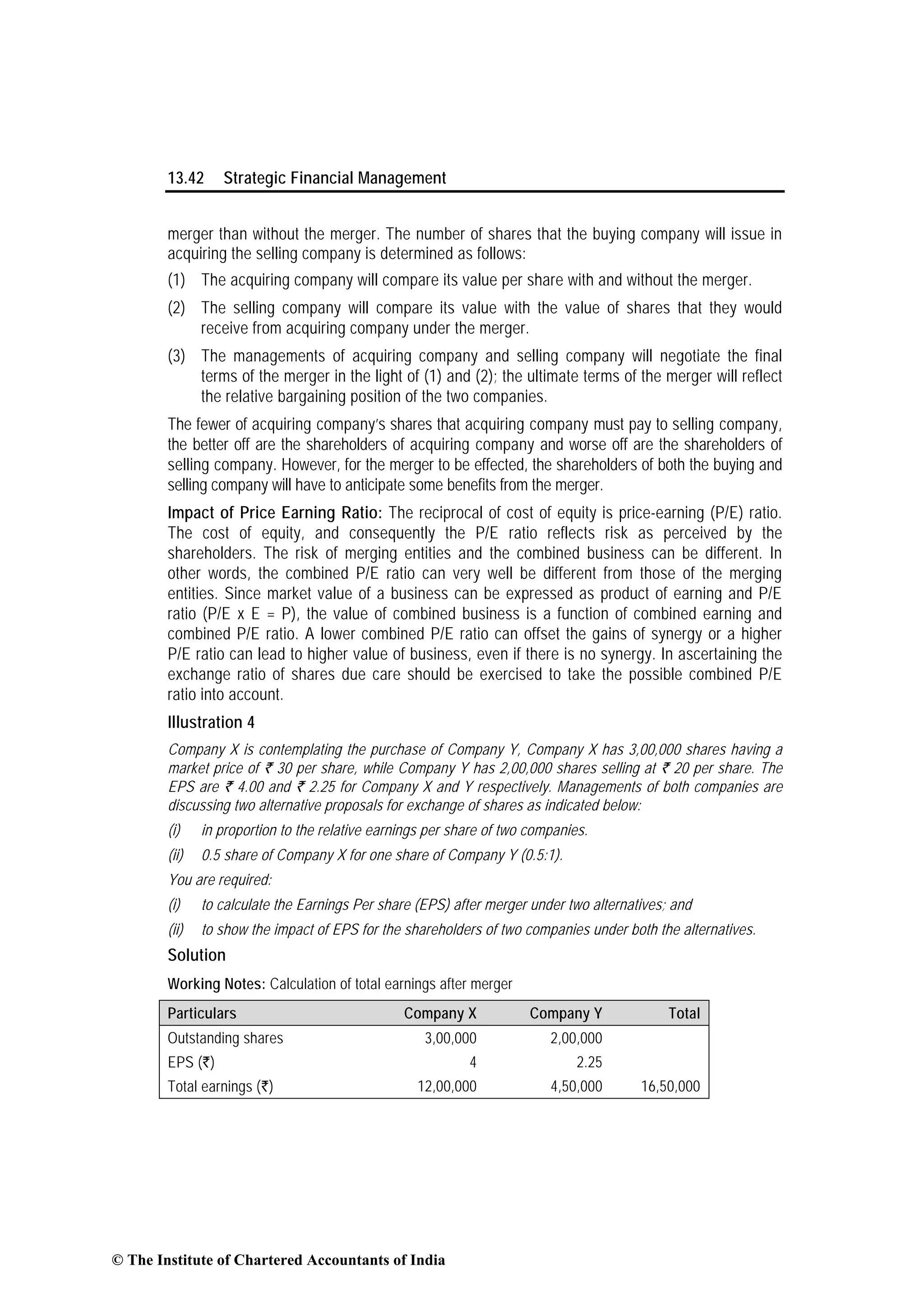
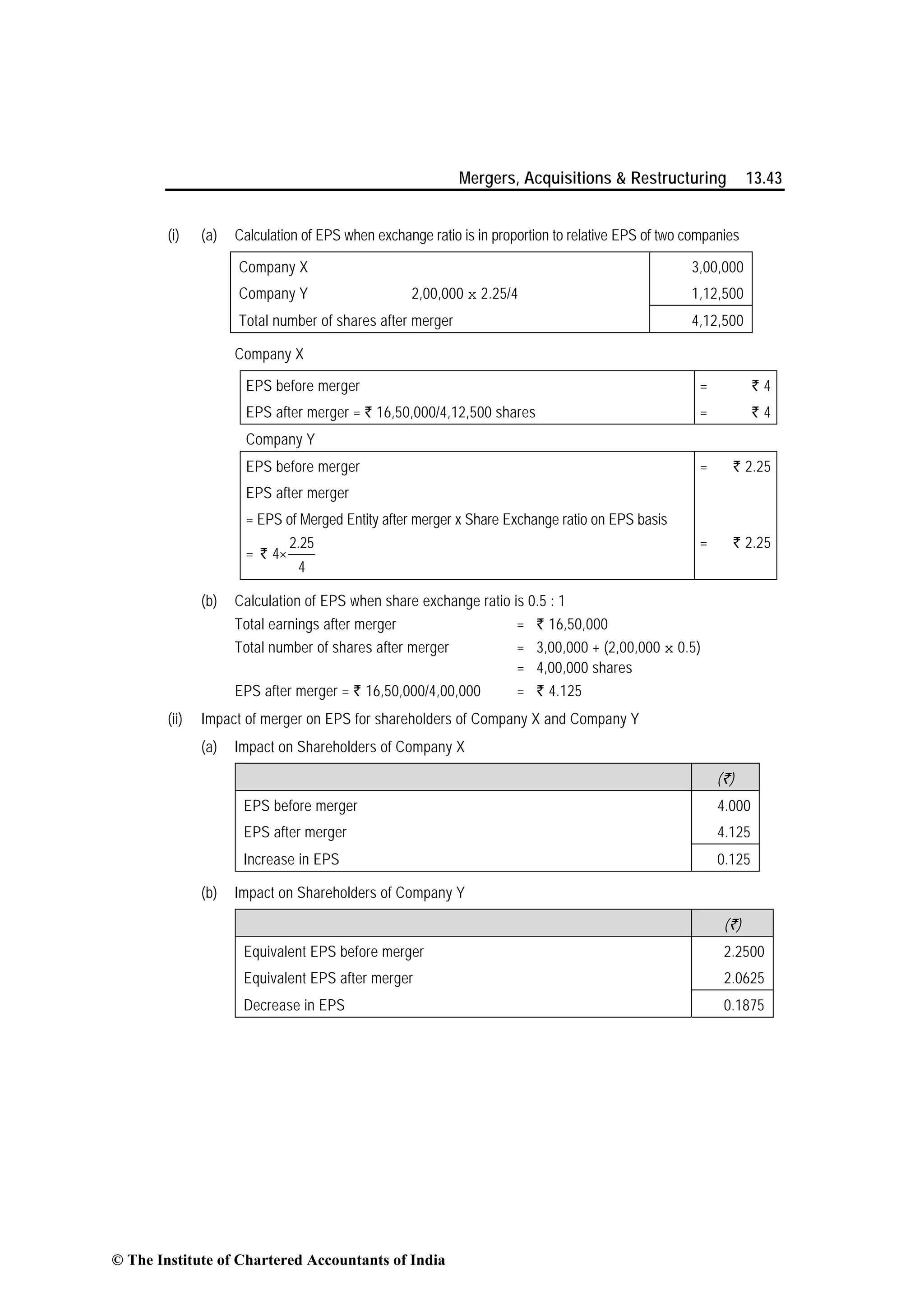
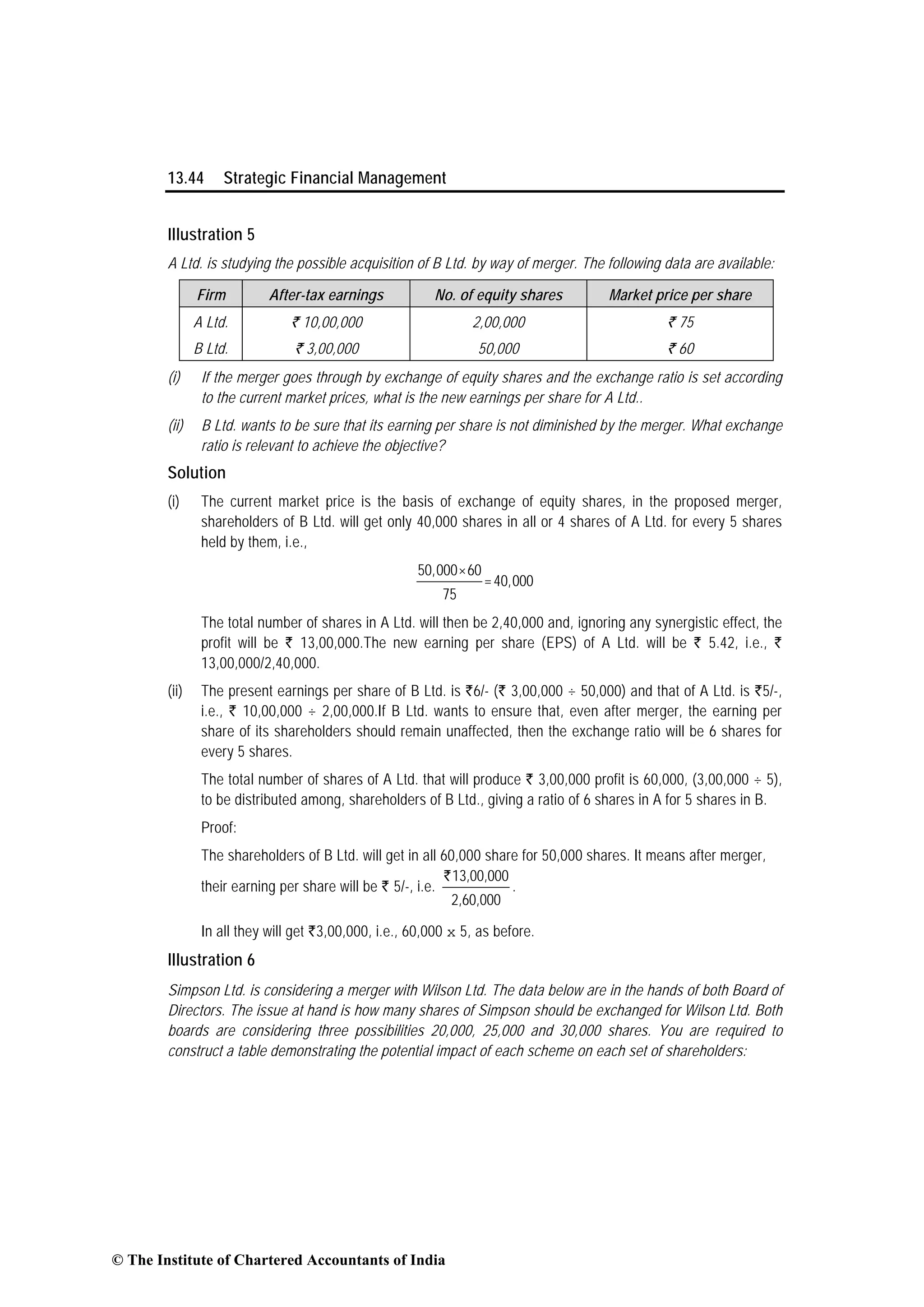
![Mergers, Acquisitions & Restructuring 13.45
Simpson
Ltd.
Wilson Ltd. Combined
Post merger
Firm ‘A’
1. Current earnings per year 2,00,000 1,00,000 3,50,000
2. Shares outstanding 50,000 10,000 ?
3. Earnings per share (`) (1÷ 2) 4 10 ?
4. Price per share (`) 40 100 ?
5. Price-earning ratio [4 ÷ 3] 10 10 10
6. Value of firm (`) 20,00,000 10,00,000 35,00,000
7. Expected Annual growth rate in earnings
in foreseeable future 0 0 0
Solution
The following table demonstrates the potential impact of the three possible schemes, on each set of
shareholders:-
Number
of
Simpson
Ltd.’s
shares
issued to
sharehold
ers of
Wilson
Ltd.
Exchange
ratio
[(1)/10,000
shares of
Wilson Ltd.]
Number of
Simpson
Ltd.’s shares
outstanding
after merger
[50,000+(1)]
Fraction of
Simpson Ltd.
(Post
merger)
owned by
Wilson Ltd.’s
shareholders
[(1)/(3)]
Value of
shares owned
by Wilson
Ltd.’s
shareholders
[(4)x
35,00,000]
Fraction of
Simpson
Ltd.
(combined
Post-merger
owned by
Simpson
Ltd.’s share-
holders
[50,000/(3)]
Value of
shares
owned by
Simpson
Ltd.’s
shareholde
rs [(6) x
35,00,000]
(1) (2) (3) (4) (5) (6) (7)
20,000 2 70,000 2/7 10,00,000 5/7 25,00,000
25,000 2.5 75,000 1/3 11,66,667 2/3 23,33,333
30,000 3 80,000 3/8 13,12,500 5/8 21,87,500
19. Cross-Border M&A
Cross-border M&A is a popular route for global growth and overseas expansion. Cross-border
M&A is also playing an important role in global M&A. This is especially true for developing
countries such as India. Kaushik Chatterjee, CFO, of Tata Steel in an interview with McKenzie
Quarterly in September 2009 articulates this point very clearly. To the following question
The Quarterly: Last year was the first in which Asian and Indian companies acquired
more businesses outside of Asia than European or US multinationals acquired within it.
What’s behind the Tata Group’s move to go global?
His response is as follows:-
“India is clearly a very large country with a significant population and a big market, and the
Tata Group’s companies in a number of sectors have a pretty significant market share. India
remains the main base for future growth for Tata Steel Group, and we have substantial
© The Institute of Chartered Accountants of India](https://image.slidesharecdn.com/chapter-13-merger-acquisitions-restructuring1-150606190922-lva1-app6892/75/Chapter-13-merger-acquisitions-restructuring-1-45-2048.jpg)
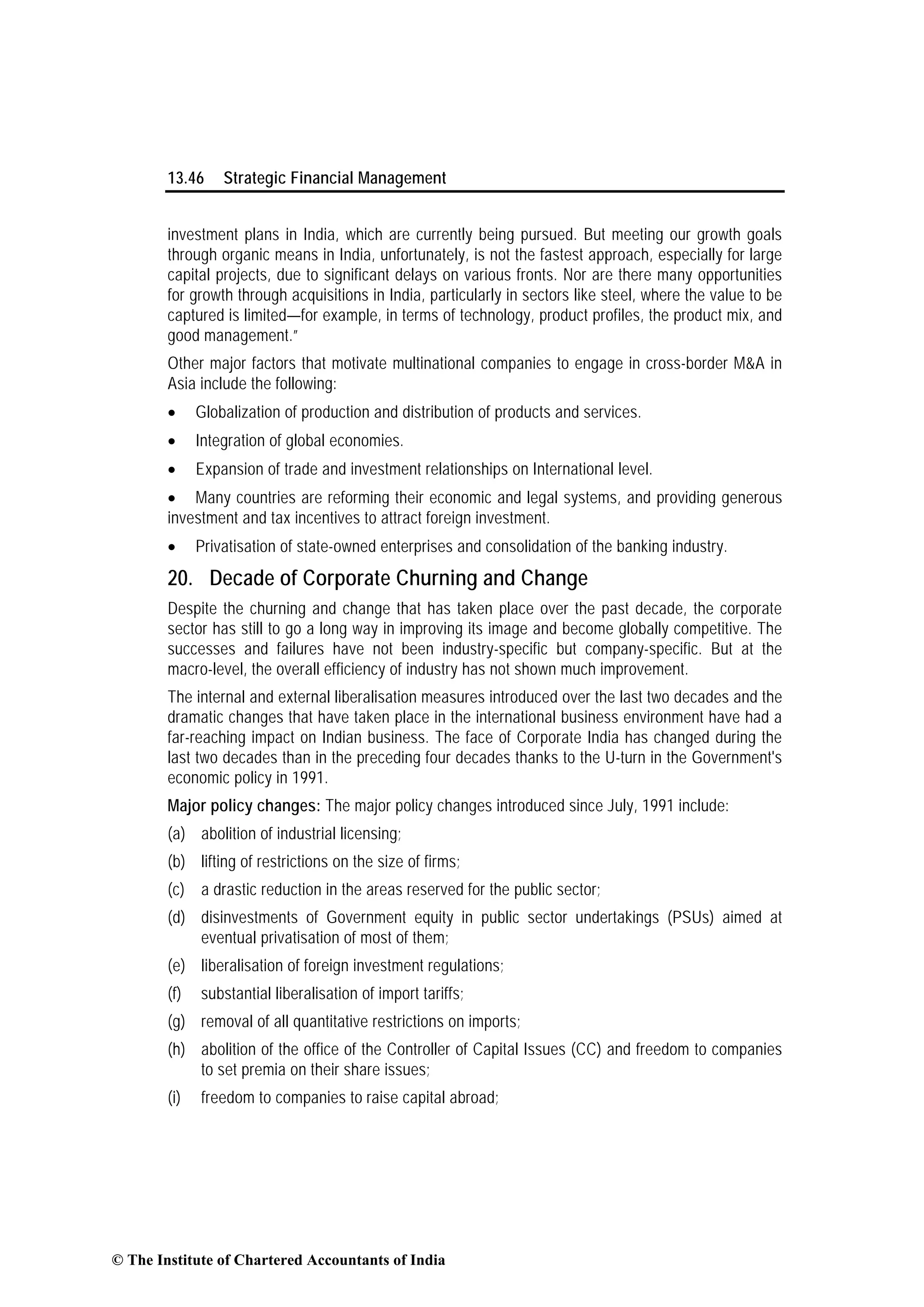

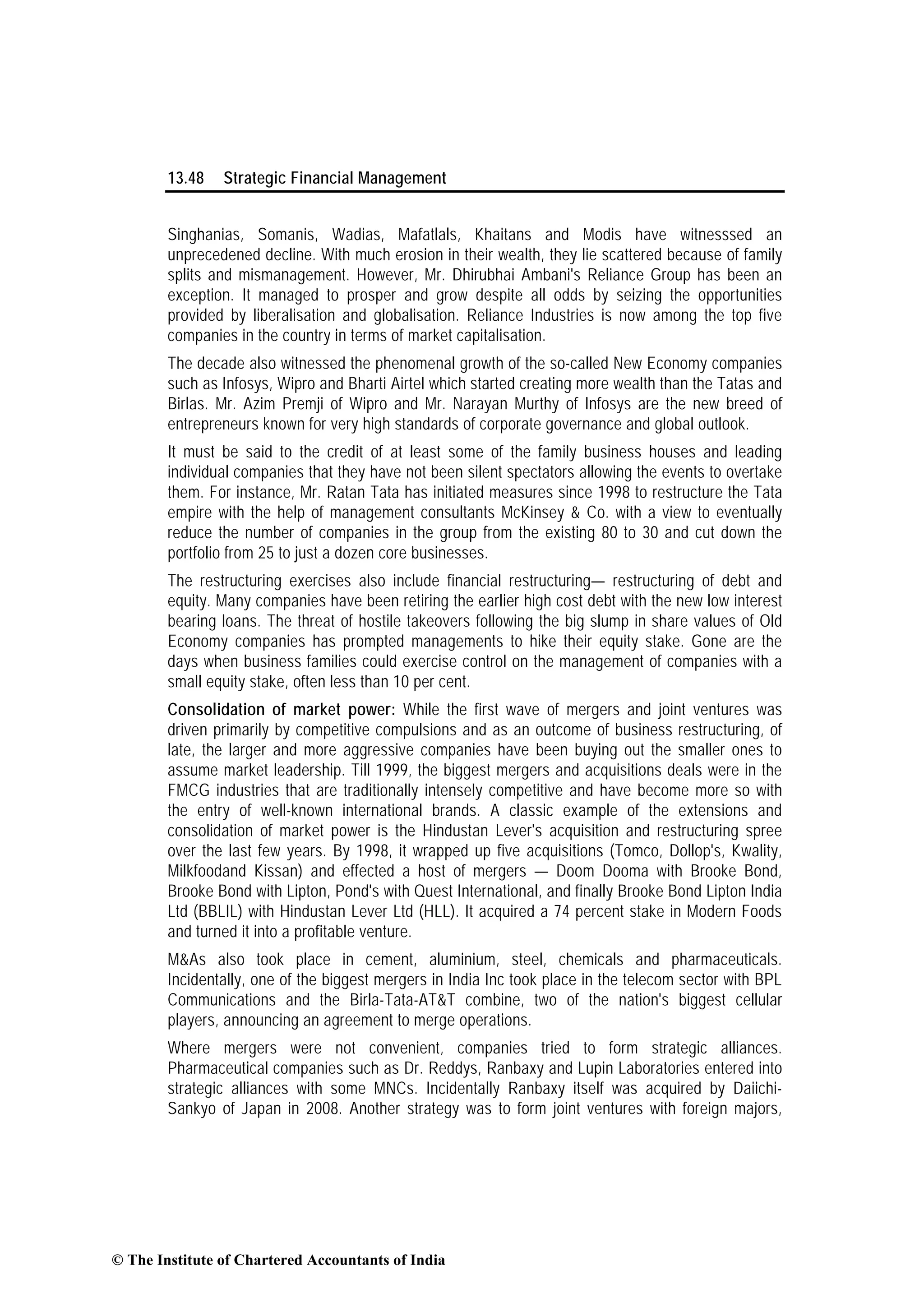
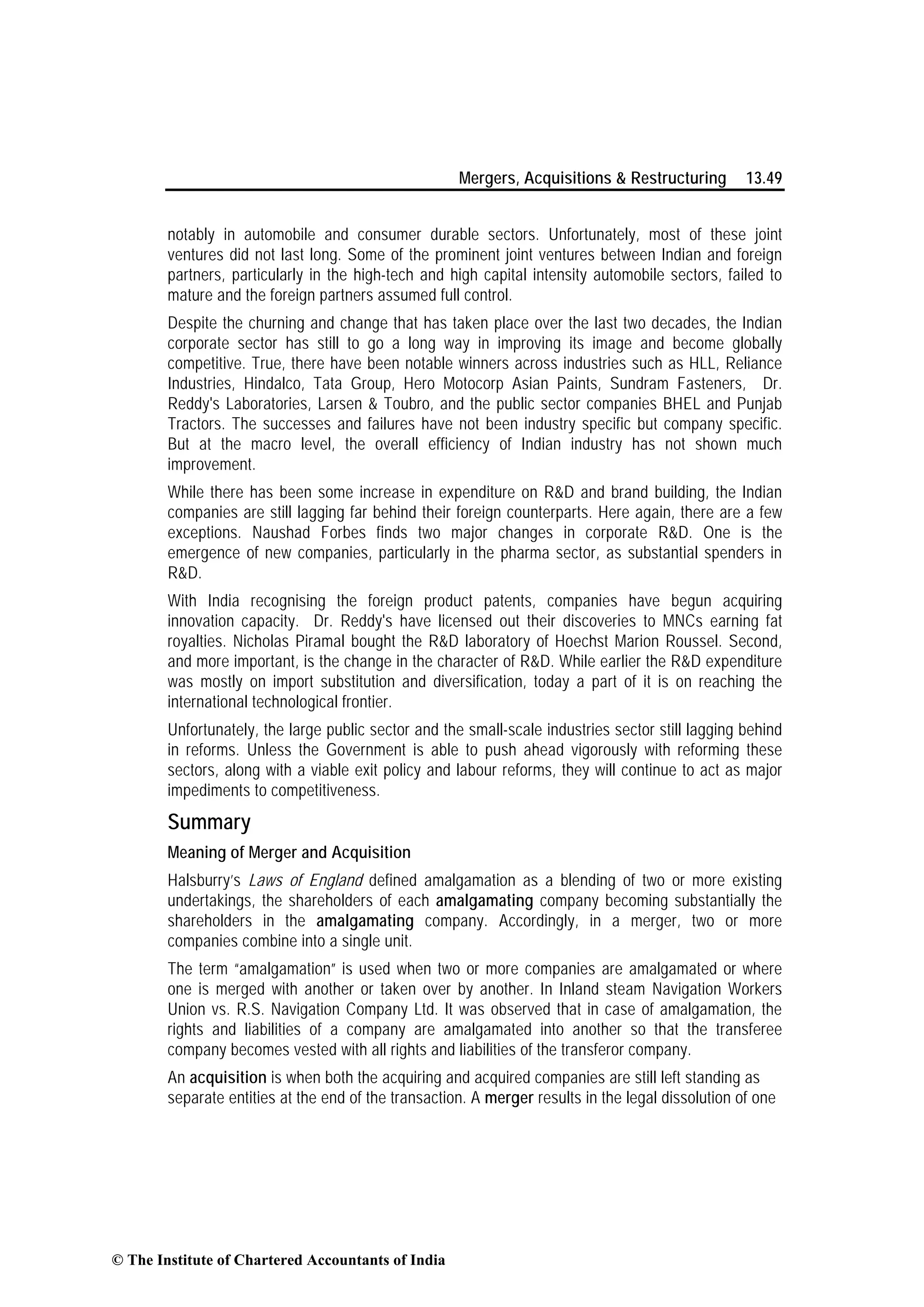
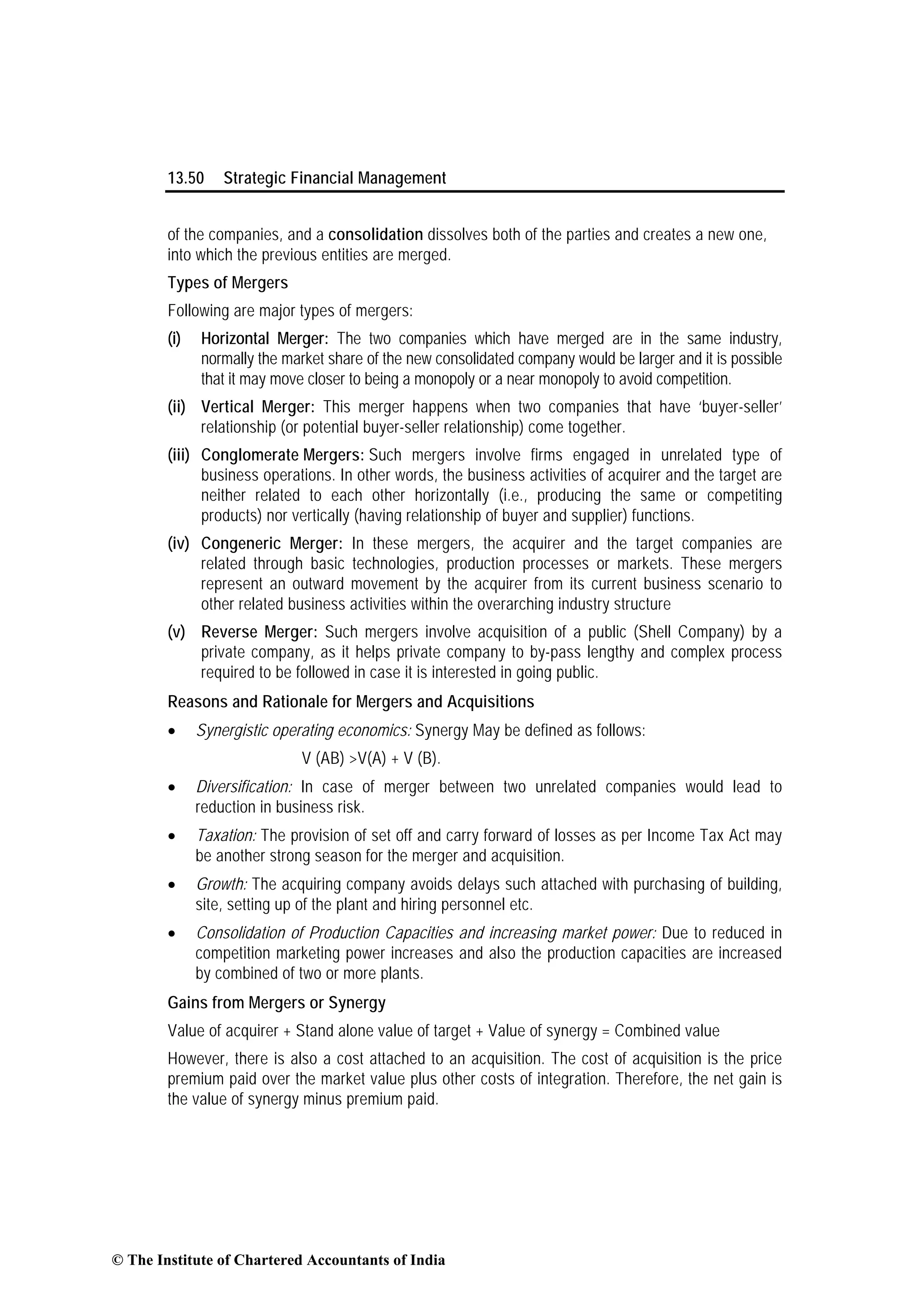
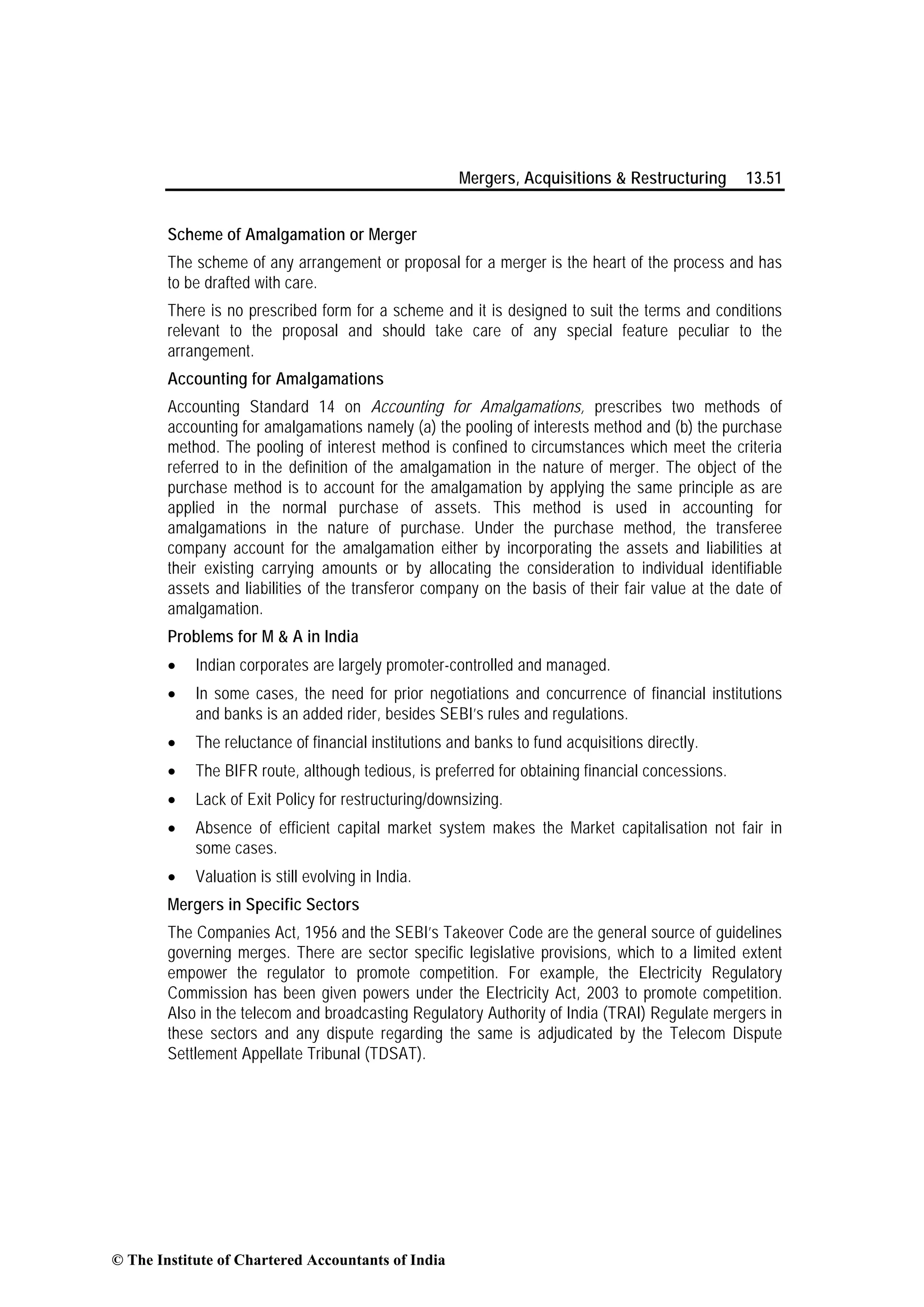
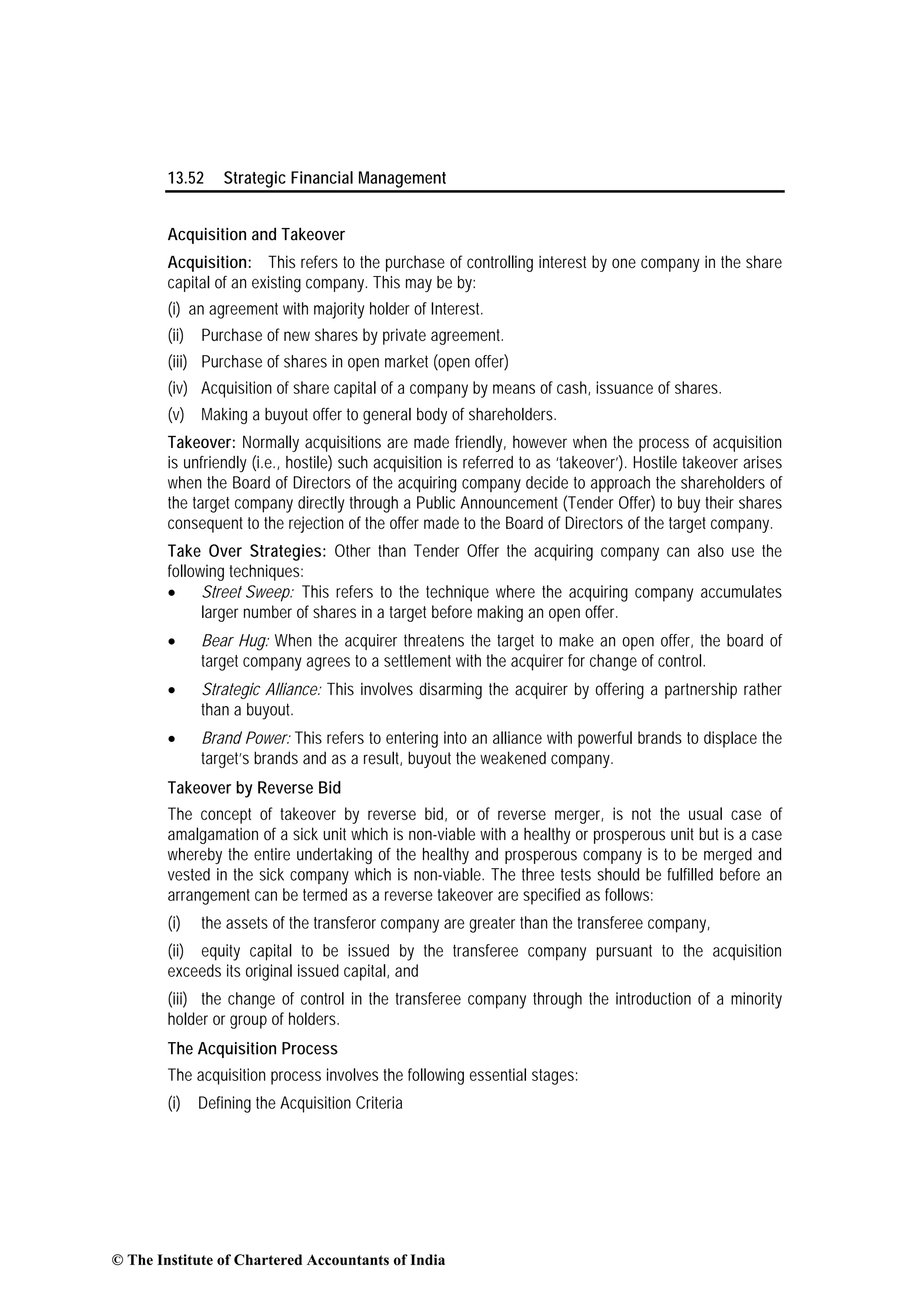
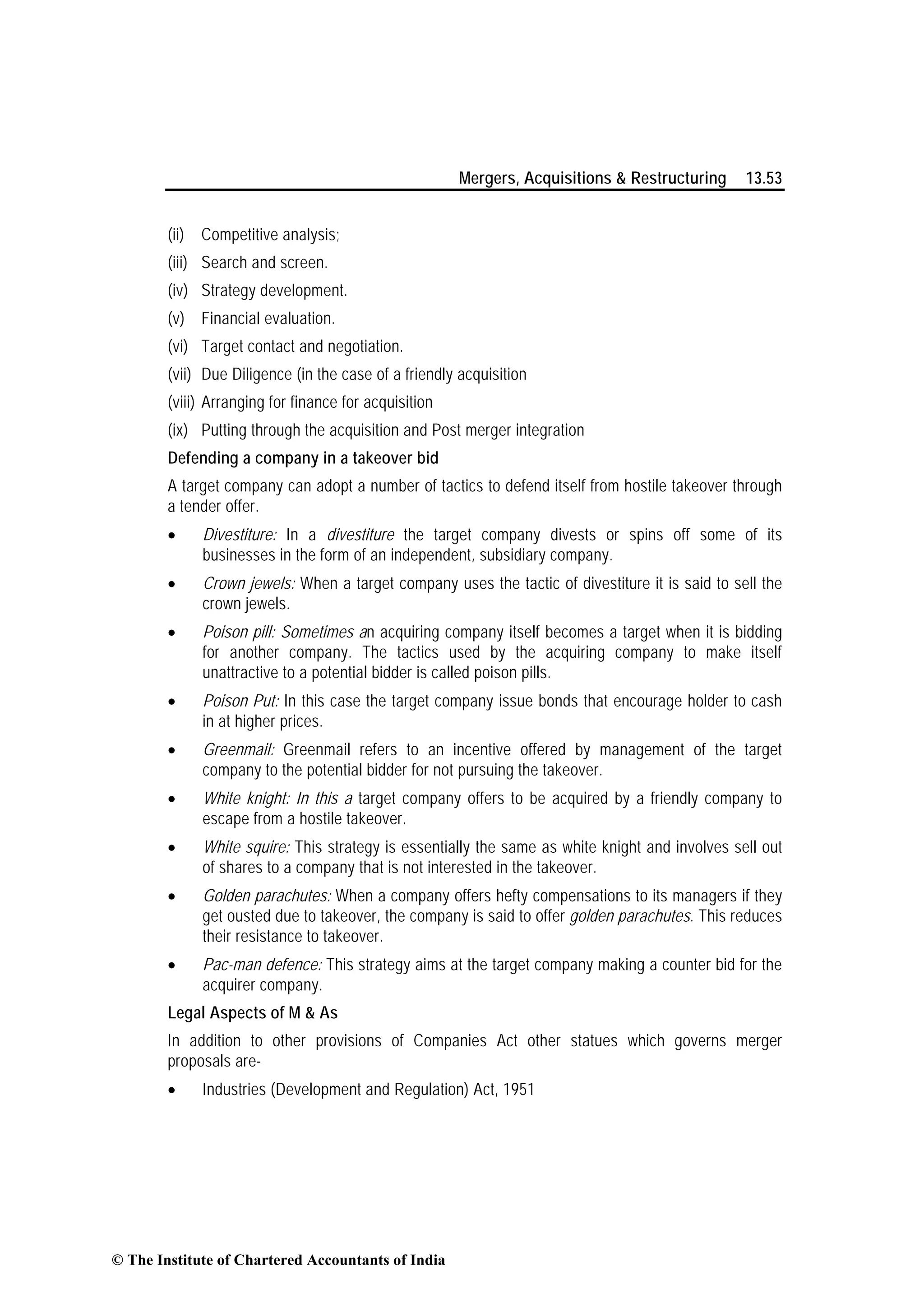
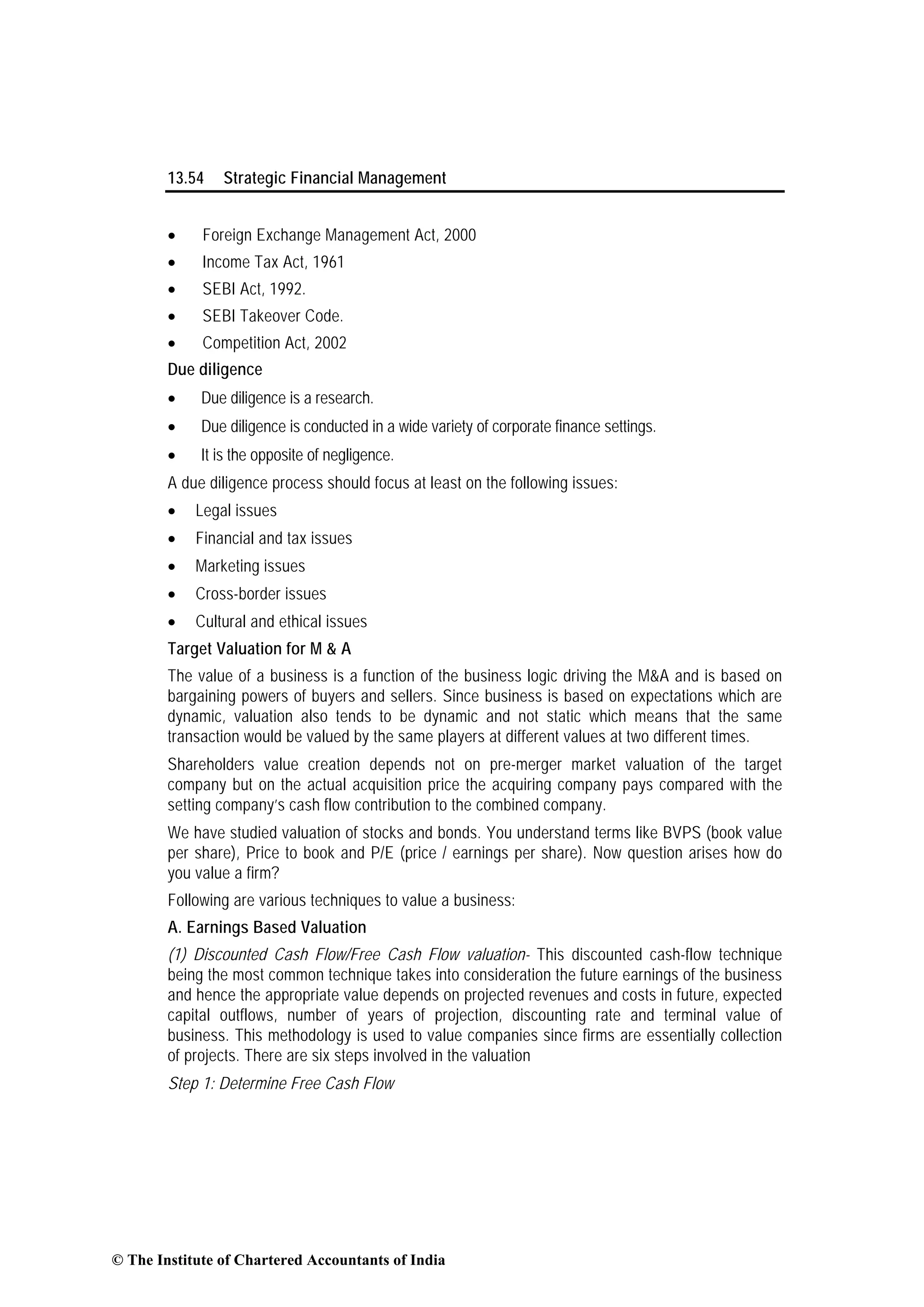
![Mergers, Acquisitions & Restructuring 13.55
Step 2 : Estimate a suitable Discount Rate for the Acquisition
Step 3 : Calculate the Present Value of Cash Flows
Step 4 : Estimate the Terminal Value
Terminal Value (TV) can be determined by using following methods:
(i) On the basis of Capital Employed
(ii) On the basis of Multiple of Earnings
(iii) On the basis of Free Cash Flow: It should however be noted that following two
approaches can be employed to compute the TV.
(a) Growing Perpetuity: Under this approach we assume that cash flow grows at a constant
rate after forecasted period and it is calculated as follows:
TV = [CFt (1 + g)] / (k – g)
(b) Stable Perpetuity: This approach is followed when there is no Capital Expenditure or if it
is there then it is equal to depreciation charged. The TV in such case shall be calculated
as follows:
TV = Free Cash Flow/ Discount Rate (Cost of Capital)
= FCF/k
(iv) On the basis of Multiple Book Value: Under this method TV is estimated by multiplying an
appropriate or available market-to-book ratio to forecasted book value of capital. Generally,
current Market Value/ Book Value (M/B) ratio is taken as proxy for the futures.
Step 5 : Add Present Value of Terminal Value = TV x PVIFk,n
Step 6 : Deduct the Value of Debt and Other Obligations Assumed by the Acquirer.
(2) Cost to Create: In this approach, the cost for building up the business from scratch is taken into
consideration and the purchase price is typically the cost plus a margin. The value of a business is
estimated in the capitalized earnings method by capitalizing the net profits of the business of the
current year or average of three years or projected years at required rate of return.
(3) Capitalised Earning Method: A common method of valuing a business is also called the
Capitalization of Earnings (or Capitalized Earnings) method. Capitalization refers to the return
on investment that is expected by an investor. The value of a business is estimated in the
capitalized earnings method by capitalizing the net profits of the business of the current year
or average of three years or a projected year at required rate of return. There are many
variations in how this method is applied. However, the basic logic is the same.
(4) Chop-Shop Method: This approach involves following three steps:
Step 1: Identify the firm’s various business segments and calculate the average capitalization
ratios for firms in those industries.
Step 2: Calculate a “theoretical” market value based upon each of the average capitalization ratios.
Step 3: Average the “theoretical” market values to determine the “chop-shop” value of the firm.
© The Institute of Chartered Accountants of India](https://image.slidesharecdn.com/chapter-13-merger-acquisitions-restructuring1-150606190922-lva1-app6892/75/Chapter-13-merger-acquisitions-restructuring-1-55-2048.jpg)
